

Yacht Types and Sizes
Which yacht types and sizes exist in the world.
Are you curious which yacht types and sizes exist in the world? Spoiler: there are plenty!
In this article, we explore different types of yachts, such as motor yachts, sailing yachts, catamarans and trimarans.
We talk about their unique features, advantages and disadvantages.
We also cover the difference between serial, semi-custom and custom yachts and see which one is right for you.
Finally, we learn about how yacht size is measured and how it affects overall yacht volume and operations.
Let’s get started!
YACHT TYPES
If you consider buying a yacht, you need to decide on its type.
Which yacht type do you prefer: motor yachts, sailing yachts or catamarans?
These three categories are the most popular types of yachts, although there are also other ones.
Let’s look at each of them separately.
Yacht Types: Motor Yachts
Motor yacht is the most common type of a superyacht. Around 80% of world’s yachts are motor yachts.
These luxury boats are powered by strong engines, do not have sails and over time have become symbol of a classy and laid-back lifestyle.
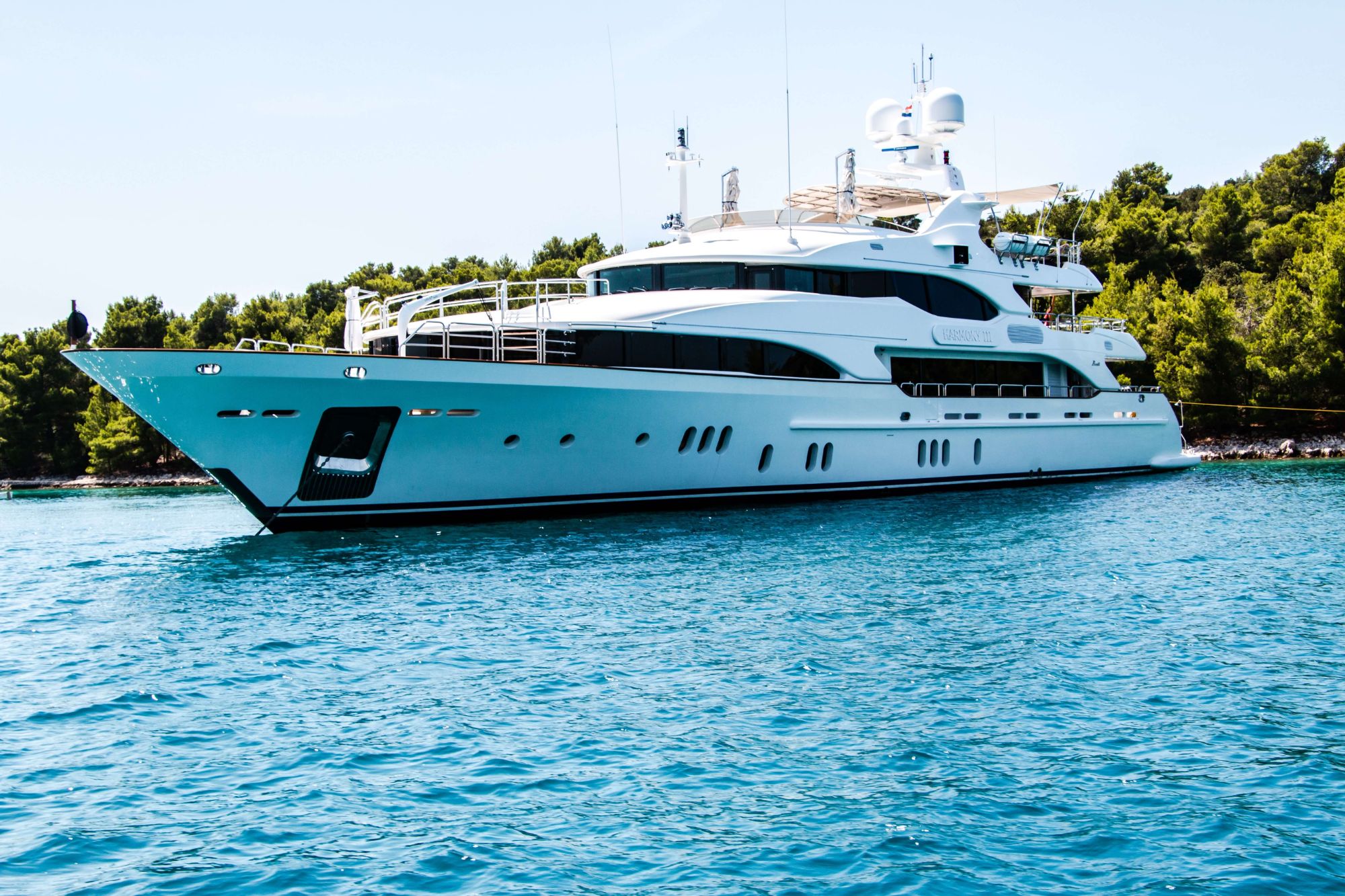
Pros of Motor Yachts:
- Powerful and fast
- Greater technological advances
- Greater deck space, more living volume
- Easier to find suitable crew members
- Easier to operate than a sailing yacht
- Easier to host guests of all personalities
Contras of Motor Yachts:
- Less sustainable, higher fuel consumption
- Less adventurous feel (if you are looking for it)
- Shorter range (can only be powered by motor)
- Engine noise
Motor yacht is probably the first thing which comes to your mind when you think superyachts.
Classy and sleek design, plenty of deck space, comfortable staterooms and lots of entertainment options – all this you can find aboard a motor yacht.
Motor yachts come in different types and sizes and with different purposes. The latest trend is explorer motor yachts, which are explicitly equipped for cruising in cold polar regions.
Yacht Types: Sailing Yachts
Sailing yachts are the second most popular yacht type. If you love the wind and want that classy sporty feel while aboard, then a sailing yacht is the right yacht type for you.
Another advantage is that when not powered by motor, sailing yachts are very quiet. It is only the sound of waves and wind (and an occasional seagull) around you.
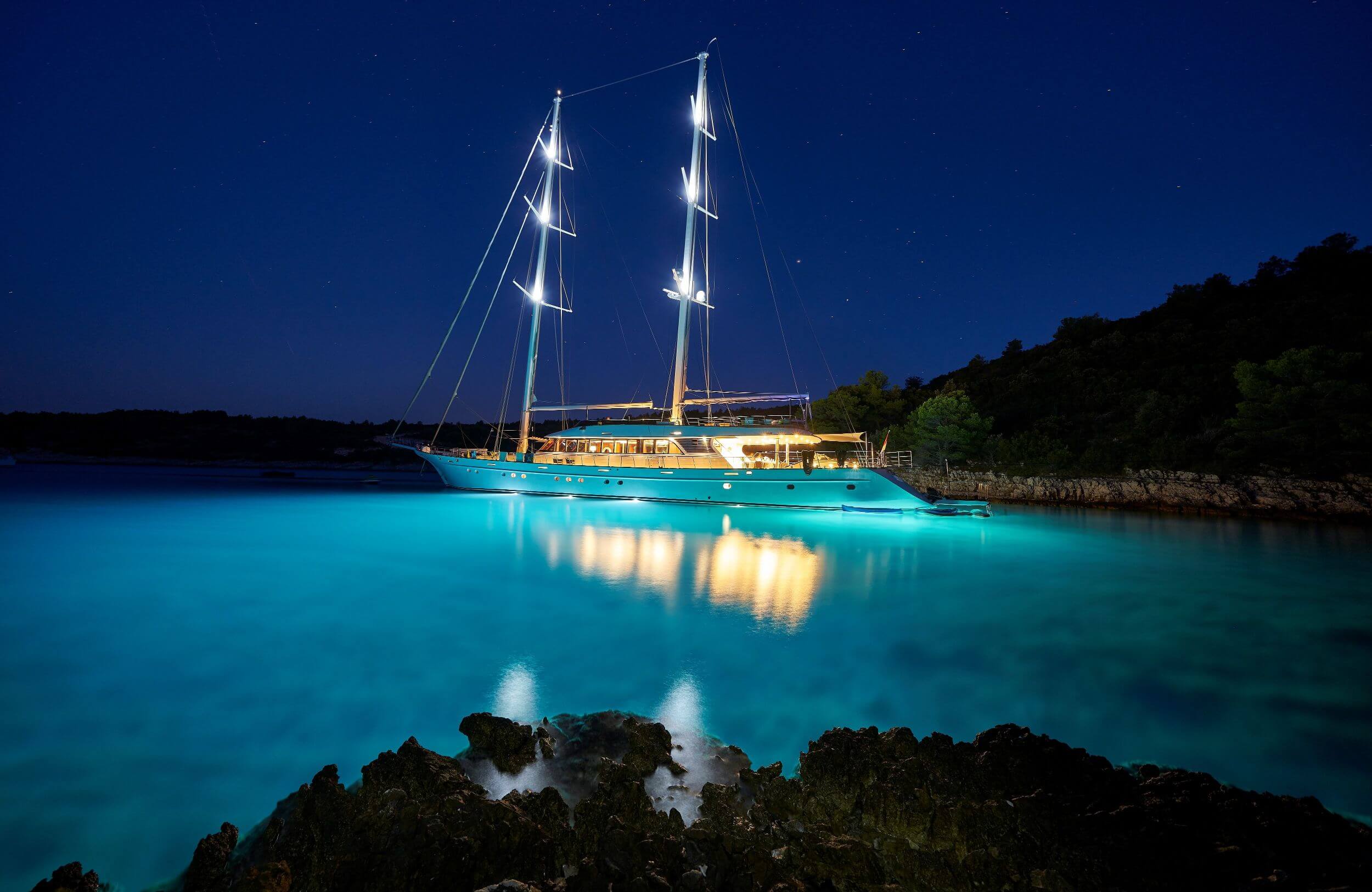
Pros of Sailing Yachts:
- Unique feel of adventure
- Can combine peaceful cruise with racing
- Very quiet when powered by sail
- Lower fuel consumption
- Lower maintenance cost
- Can sail in shallower waters
Contras of Sailing Yachts:
- Tend to be slower that motor yachts (in case you like speed)
- Less stabilization
- Smaller cabin space
- Might have less lifestyle equipment available (Jacuzzi, gym, cinema) …
There are only two types of people out there: sailing yacht fans and motor yacht fans. Rivalry between fans of the two yacht types has become legendary.
Probably, you already know which group you belong to. Nevertheless, we still recommend you charter both sailing and motor yachts to be sure you are making the right choice. If you are still unsure, read about the third yacht type below.
Yacht Types: Catamarans
Catamaran is defined as a vessel with two parallel hulls which are joined together. Due to its form, catamaran is the most stable of all yacht types.
If you are looking for stability and comfort, or have family members who easily get seasick, buying a catamaran is a valid option to consider.
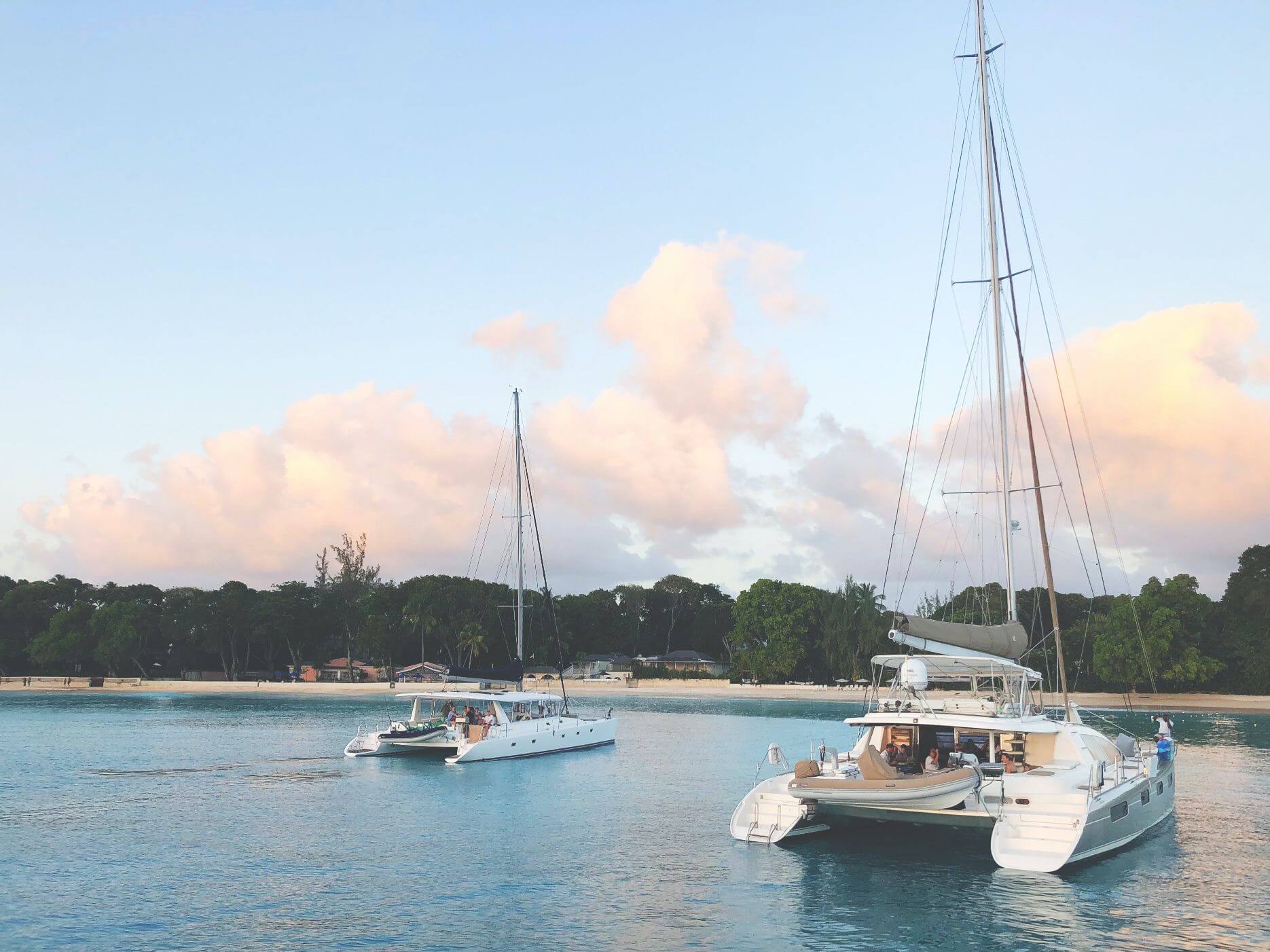
Pros of Catamarans:
- More fuel efficient & sustainable
- More stability
- Can be used in shallow waters
Contras of Catamarans:
- Less volume for staterooms
- Higher dockage rates than for a monohull
- Different sailing feeling compared to a sailing boat
Catamarans offer a great opportunity for taking family vacations, which will leave every family member happy. Since they are more difficult to sink, they are also considered the safest boats.
If you are looking for extra stability, comfort and space, but also do not want to compromise on adventures and possibility to explore shallow waters, catamaran is right yacht type for you.
Yacht Types: Trimarans
Big brother of a catamaran, a trimaran, has even three hulls – one main hull in the center, and two smaller hulls on each side.
You will not see them as often, but there are certainly also big fans of trimarans out there. Trimarans are designed for racing or leisure but are also widely used for military and shipping purposes.
YACHT PRODUCTION TYPES: SERIAL, SEMI -CUSTOM, CUSTOM YACHTS
Now that we’ve covered yacht types, let’s investigate which production options are out there. Unlike the automotive industry where most of the car models come from production lines, the yachting world offers future owners more possibilities.
SERIALS YACHTS
This is the most common and less expensive way to get to your new dream boat. Serial or production yachts are yacht models which are produced by shipyards in various quantities based on model and size.
Serial does not mean that you cannot tune it to your taste though. Manufacturers offer different sets of modifications with certain yacht models. You will likely get to choose between several layout models and different equipment options.
Obviously, if you order a newly build yacht, you are likely to get more space for your improvements, than if you decide to refit an already existing yacht.
SEMI-CUSTOM YACHTS
A good way for owners who wish more character and comfort to their boats but at the same time do not want to order a fully customized vessel, is to order a semi-custom yacht.
Semi-custom yachts stand between serial and fully customized boats. You save a lot of time and effort by picking an existing engineered platform from which to start planning.
Then, together with experienced naval architects and designers, you enhance it up to your expectations by customizing layout (possibly including superstructure) and interiors.
Ordering a semi-custom yacht gives you more freedom to decide how your yacht will look like. Construction time is also much shorter in comparison with a fully customized yacht, since many parts are already designed, engineered and possibly even pre-built.
By ordering a semi-custom yacht, you can shorten construction time from two – three years up to several months!
Shipyards are also less likely to fall behind the delivery schedule, since they have produced similar yachts before and know which time is needed for delivery.
Most semi-custom yachts are designed to suite majority of potential future owners, which means that layout, size, engineering etc will be well thought-through in advance.
Due to extensive previous testing & refining of semi-custom hulls by the shipyard, it is possible that your new yacht will turn out more reliable and problem-free than a fully customized yacht.
CUSTOM YACHTS
If you wish to be unlike anybody else and want to take your dream a step further, a fully custom-built yacht is exactly what you need.
Almost anything is possible and achievable in today’s superyacht building industry. The only considerations are your budget and international safety and security standards, more on which you can read in our article on Safety and Security Onboard Superyachts.
With a custom-made yacht, you can be sure you will get exactly the boat you want, tailored just for your preferences, no other yacht in the world being similar.
Consider longer delivery time and substantially higher cost, since R&D expenses are not shared between yachts of the same series.
Many owners buy a smaller replacement yacht, while they are waiting for their customized dream boat to leave the docks.
A fully customized superyacht is surely the most exclusive type of a yacht one can own.
Yacht Sizes
Now let’s look at different yacht sizes. But first, let’s find out what yacht size actually is.
How is yacht size measured?
Length Overall (LOA) is the most widely used metrics of yacht length. It is measured from the aftmost tip of the hull to the furthermost point of the stem, measured parallel to the waterline. It is probably the only yacht length definition you need to know as an owner.
*For yachting geeks out there, here are other yacht size definitions used in the industry:
Length of Deck (LOD) : deck length excluding bow sprits and other projections. Makes particular sense for sailing boats, since their Length Overall can considerably vary from their Length of Deck.
Length of Hull (LH or LOH): Length of hull including fixed fendering but excluding any bow sprits. It can be shorter than LOA.
Length of Waterline (LWL): length of a boat at the level where the boat sits in the water.
Interesting fact: Did you know that with each additional 1 meter of length, the internal volume of a yacht increases by 6-7 cubic meters? A 40-meter yacht is not just twice longer than its 20-meter companion. According to Cube Law, it is also 6-7 times larger in volume!
Motor yacht sizes by group
Let’s look at different sizes of motor yachts. To make things easier, we divided them into 4 groups.
Please note that the following crew and guest numbers per yacht size are only approximate.
Factual crew numbers will depend on specific yacht length, cruising style, owner preferences and whether the yacht charters or not.
Factual guest numbers will depend on yacht registration type, especially with larger yachts.
22 – 40 meter motor yachts
Motor yachts in of this size are most likely serial production yachts. This means that you can buy a specific yacht model which has been designed before, and choose your own details, such as finishings and furniture.
Yachts of this size will need 4-6 crew members: yacht captain, one or two deckhands, one or two stewardesses, a yacht chef, and presumably an engineer.
22-40 meter long motor yachts normally can host up to 8 guests.
40-60 meter motor yachts
Motor boats of 40 meters length and larger are considered superyachts also within circles of superyacht industry professionals.
This is where operations and crew requirements become considerably more sophisticated. There are also more semi-custom and custom boats in this size segment.
A 40-50 meter motor boat will require a crew of approximately 9-13 crew members, depending on specific owner requirements and cruising / charter preferences.
A possible crew setup would be: yacht captain, first officer, bosun, two engineers, three or two stewardesses, two deckhands, one or two chefs (often a guest and a crew chef).
Crew of a 60 meter motor yacht will count around 20 members.
40-60 meter long motor yachts normally can host up to 12 guests.
60 – 80 meter motor yachts
Here the yachts grow much larger, and so do the costs of maintenance.
A yacht of 60 meters length will have a crew of 20-23 members. A yacht of 80 meters length can have a crew of up to 80 members.
The maximum number of guests will depend on yacht registration type. Many owners choose to keep maximum of 12 guests, since it allows for a simpler regulation regime.
80 – 180 meter motor yachts
A 100 meter motor yacht will require 80-100 members crew. Its tonnage will exceed 500 GT, which means that the yacht will fall under more regulations: STCW, SOLAS, ISSC, ISM and others.
A 170 meter motor yacht can have up to 100 crew members.
The largest yacht worldwide at the time of writing is Azzam, at 180 meters built by Lürssen. Azzam can host 36 guests and a least 80 crew.
Maximum guest number on a yacht of this size can still be only 12 guests. But if the yacht is registered as a passage vessel, it can be significantly more.
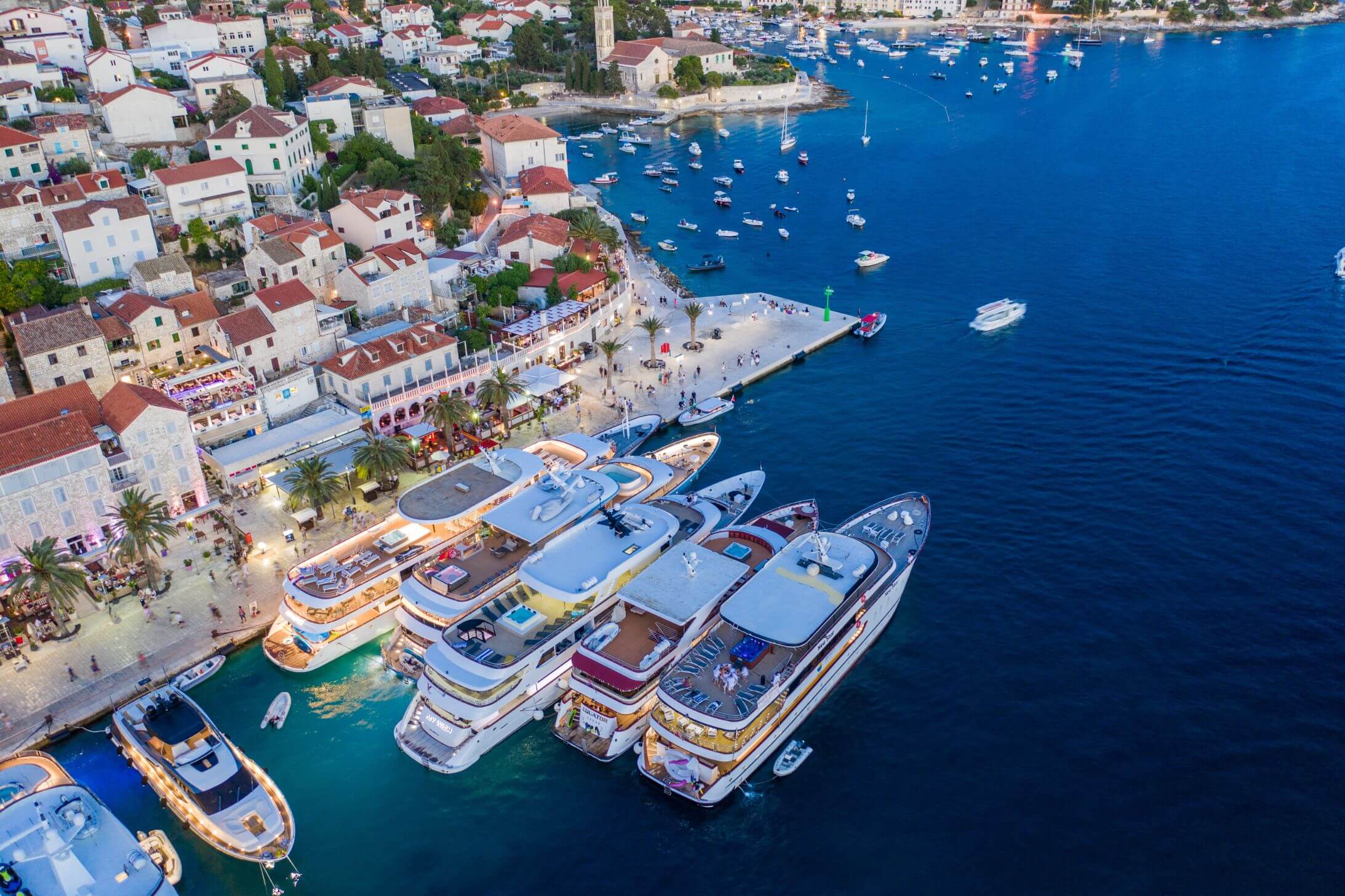
How does yacht size affect my yachting experience?
Size does matter after all.
Let’s look at factors that change with the growing size of a yacht.
While thinking of upgrading to a bigger vessel, do not forget that as the yacht size grows, following factors also increase:
- Yacht price
- Availability and price of marina dockage
- Fuel consumption
- Number of full-time crew members
- Time you can spend away from ports
- Quantity of water and other supplies the yacht can carry
- Functionality and entertainment options
- Complexity of repairs
- Applicability of laws & regulations
- Time needed to sell the yacht
Budget is the main factor which determines how big your boat can be. To learn more about the cost of yacht ownership, read this article.
During the past decade, superyachts increased in size dramatically, and this trend continues. According to an article by Boat International, there has been around 10.000 yachts over 24-meter LOA in the world. Around 80% of them were motor yachts.
Most of the owners start small and upgrade their boats over years. Once you owned a smaller yacht for some time, you will understand exactly what you love about it.
Also, you will know what you want to improve. So why not initiate a new-build of a new more exciting and possibly larger boat? You can still have the older yacht at your disposal, while waiting for the new delivery.
SUMMARY: YACHT TYPES AND SIZES
In this article, we classified all yachts into 3 main types: motor yachts, sailing yachts & catamarans. We also discussed their pros & contras.
We explained the difference between serial production, semi-custom and custom yachts.
Finally, we learned how yacht size is measured and how it affects various aspects of yacht operations. We looked at crew and guest numbers for each yacht size.
Another important factor to consider is whether you want to commission a new-built yacht or buy a second hand one . More on this in our next article .
Drop us an email if you need help with choosing a yacht or booking a yacht charter. We will define your needs and find the best solution together.
Are you a motor yacht, sailing yacht, or catamaran fan?
Comment below!
Article by Olympiada Wohlin-Elkovsky from Yachtowner.co
More Articles
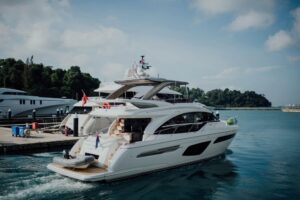
Should I Buy a New or a Used Yacht?

Superyacht Brokers List
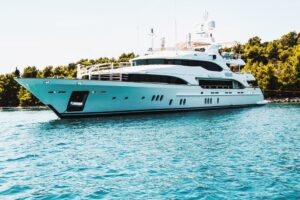
How to Buy a Yacht
Leave a reply cancel reply.
Your email address will not be published. Required fields are marked *
Save my name, email, and website in this browser for the next time I comment.
Yes, add me to your mailing list
Privacy Overview

How Big Are Yachts? 5 Types Explained (With Numbers)
Yachts can come in a variety of sizes and weights. Before you purchase a yacht, you must know what size yacht you need.
The size and weight of the yacht that you need will depend greatly on what your intended use is for the yacht that you are purchasing.
Table of Contents
Here’s everything you need to know about the weight of yachts:
Here’s an Idea of How Big Yachts Are:
The term “Yachts” refers to a pleasure vessel that is at least 30 feet in length and has some type of cabin with some amenities. The biggest luxury yacht is 590 feet (180 meters) and 13,136 gross tons.

What Do We Mean When We Talk About Weight?
There are two types of weight for a boat, dry weight, and wet weight.
Dry weight is the weight of the boat without any fluids in the tanks. Wet weight is the weight of the boat with the fluids in the tanks.
You can also have a loaded weight, which is the wet weight, including any additional toys or equipment you have stored onboard.
What Do We Mean When We Talk About Length?
There are many different ways to calculate a boat’s length. For this reason, you want to make sure that you have a clear idea of what the length of your boat really is.
The boat’s registered length is generally the maximum overall length, which is the length on deck plus any bowsprit or swim deck. The length of the boat on the waterline is also an important boat characteristic that you should know.
Due to the shape and construction of the hull, these numbers may differ.
For example, if you have a boat that has a 50-foot deck with no bowsprit, your registered length will be 50 feet.
Some boats are measured using “LOA,” otherwise known as length overall.
Why Is Knowing The Weight And Length Important?
The most important reason to know your boat’s weight and length is for when you choose to shop for trailers or even to determine if your vehicle can haul it.
If you try to tow a boat without an accurate representation of the weight or length, you can ruin your vehicle’s engine and even your towing equipment, not to mention have serious safety issues.
Another reason to know about your vessel’s weight is to know how much you can bring for your trip without packing more than the maximum weight allowed.
It is also important to know your weight and how it can affect your boat, especially when it comes to speed.
Different Types of Boats and Their Average Weight and Length
Below are some different types of boats and their average size and weight, and the factors that go into them.
1. Luxury Yacht

Yachts are normally classified as any watercraft that can be used for pleasure or sport and can range from 30 ft to over 100 ft.
While a yacht can be as small as 30 ft. long, a yacht is often considered a cabin cruiser until it is 39 ft. or more, then it is considered a proper yacht.
A yacht would be considered a large yacht once it’s length is over 79 feet. A yacht is considered a superyacht or megayacht if it is over 115 feet long.
The yacht the holds the record for being the longest yacht is 590 feet long. This yacht is called the “Azzam” and has held onto its title for over 5 years.
Because of the wide variety of sizes, the weight can vary greatly when it comes to yachts, and it is hard to nail down an average.
Some more distinctive differences between yachts include:
- These yachts are single-deck yachts with one living quarter below . They are often sleek and sporty.
- Also known as a sedan bridge or sport bridge yacht. This yacht has an area on top of the superstructure that features a view all the way around the vessel.
- This deck up top can offer a control station or even lounge seating, depending on its size.
- Also known as a pilothouse motor yacht, cockpit motor yacht, or sky lounge. This term can be used for any large recreational vessel that is motor powered.
- Usually, this means a multi-deck vessel similar to a flybridge but instead has a large interior deck.
- Often classified as a mega yacht, which is normally any vessel 80 ft. or more. This vessel is exactly what it sounds like.
- It is a yacht with three levels of enclosed living space.
- A sportfishing yacht is any yacht that is geared towards fishing.
- They often have areas designated to storage for rods, bait, tackle, and even areas to store the day’s catch.
2. Sailboats

Large sailboats are yachts propelled by sails and can be found in lakes, rivers, and even out on the ocean. Today, they almost all have auxiliary power in the form of an engine.
While the weight and length of a sailboat can drastically vary, the average weight of a sailboat is about 8,800 pounds. This weight does not include added gear, equipment, or fluids.
The weight will vary greatly depending on the length of the sailboat. Sailboat lengths can range between 8 feet to 472 feet.
The 472-foot sailboat also carries three masts that tower at over 91 feet each. This can definitely add more weight than the 8-foot vessel.
Listed below are 6 examples of sailboats and their weights and lengths:
- Catalina 16 LOA: 16 ft. 4 in. Hull Weight: 430 pounds
- Hunter 22 LOA: 21 ft. 4 in. Hull Weight: 3,200 pounds
- C&C 27 LOA: 27 ft. 4 in. Hull Weight: 5,180 pounds
- Erickson 28.5 LOA: 28 ft. 7 in. Hull Weight: 8,500 pounds
- Pearson 39 LOA: 39 ft. 3 in. Hull Weight: 17,000 pounds
- Swan 48 LOA: 47 ft. 11 in. Hull Weight: 36,000 pounds
3. Speed Boats (Cigarette Boats)

Speed boats are sleek and built for achieving high levels of speed.
These boats are not made for watersports and should not be confused with ski boats.
A speed boat’s average weight is slightly less than that of a sailboat at roughly 8,000 pounds.
Some of the factors that determine a speed boat’s weight can include their length, engines, and sleekness.
Listed below are some examples of speedboats and their weights and lengths:
- Cigarette 38 Top Gun LOA: 37 ft. 8 in. Hull Weight: 9,175 pounds
- 32 Thunder Cat LOA: 32 ft. Hull Weight: 5,400 pounds
- M35 LOA: 35 ft. 4 in. Hull Weight: 9,250 pounds
4. Deck Boats or Pontoon Boats

Deck boats and pontoon boats both have large decks and are mostly intended for recreational use.
Pontoon boats have the lowest average weight at 3,100 pounds .
Because they do not have large hulls, they can be lighter and cut across the water easier than boats with larger hulls.
Listed below are some examples of deck boats and their weights and lengths:
- NauticStar 211 Angler (Deckboat) LOA: 20 ft. 9 in. Weight: 2,100 pounds
- Stingray 212SC (Deckboat) LOA: 21 ft. 11 in. Weight: 3,100 pounds
- Hurricane SunDeck 2690 LOA: 26 ft. 4 in. Weight: 4,475 pounds
5. Cabin Cruisers

Cabin cruisers are large boats that are sometimes looked at as mini-yachts.
These boats allow for sleeping accommodations and other luxuries afforded in their cabin space.
Like the sailboat, a cabin cruiser’s weight can vary. However, they do tend to have a smaller range than sailboats.
The average weight of a cabin cruiser is about 8,700 pounds.
One of the major factors in the weight of cabin cruisers is the size of the sleeping accommodations below. Some models of cabin cruisers can even sleep up to 10 people.
Listed below are some examples of cabin cruisers and their weights and lengths:
- Larson 274 Cabrio LOA: 28 ft. Dry Weight: 6,001 pounds
- Rinker 301 Express Cruiser LOA: 32 ft. Dry Weight 7,640 pounds
- Bayliner 285 SB LOA: 28 ft. 9 in. Dry Weight: 8,056 pounds
Picking a Yacht:
Yachts can vary in a wide array of sizes, weights, styles, and even purposes.
You can race them, fish on them, and cruise around at an easy pace.
You can take a day trip or even take personal cruises that last days or weeks.
With ample deck and cabin space that offers activities, sunbathing, kitchens, lounges, and sleeping quarters, a yacht is often the most comfortable way to experience the open water.
To choose a yacht, you will want to know what type of yacht you are looking for and what you want to use it for.
You also want to make sure when picking a yacht; you make sure you keep the weight and length in mind to make sure you have a proper towing vehicle and trailer for your vessel.
Click to share...

.css-7gvbs7{max-width:var(--chakra-sizes-full);}@media screen and (min-width: 48em){.css-7gvbs7{max-width:600px;}} Comparing Yachts: What to Know About the Size and Style of Your Yacht
Understanding types of yachts, motor yachts, sail yachts, sportfish yachts, flybridge yachts, expedition yachts, yacht sizes and classifications, choosing the right yacht type.
Want to know the different luxury yacht types? Read on to find out about everything from power-packed motor yachts to eco-friendly sailing yachts, stable catamarans to speedy trimarans. Discover the features and benefits of each yacht type to find your ideal vessel.
Yachts come in various types including motor yachts, sailing yachts, catamarans, trimarans, sportfish yachts, flybridge yachts, trawlers, and expedition or explorer yachts, each offering its own features and benefits depending on the intended use and personal preferences. Super yachts, typically at least 78 feet or 24 meters in length, are known for their unparalleled level of luxury, featuring top-notch amenities and spacious interiors.
Motor yachts are known for their luxury, speed, and spacious interiors, making them ideal for long-distance cruising and entertaining, while sailing yachts provide a serene and eco-friendly experience powered by wind.
Choosing the right yacht involves considering factors such as intended use, size, and production type (serial, semi-custom, or custom), and working with professionals like YachtLife yacht brokers to ensure an informed and secure chartering process.
The term “yacht” conjures images of sleek, luxurious vessels gliding through open waters, but the reality is that yachts come in a variety of types, each with its own history and characteristics. The most popular types are motor yachts, sailing yachts, catamarans, and trimarans.
Motor yachts are known for their luxurious features, powerful engines, and are perfect for hosting gatherings, extended cruising, and exploring new destinations. Each offers a unique experience, whether it’s the thrill of high-speed cruising, the serenity of wind-powered travel, or the unparalleled stability of multi-hull designs.

Motor yachts, known for their power and luxury, are fuel-powered vessels available in a variety of sizes and types. They are designed for hosting gatherings, extended cruising, and exploring new destinations. They can have single- or twin-screw propellers, multiple decks, spacious interiors, and an array of entertainment options.
A motor yacht is engineered for speed and efficiency and is the most common type of superyacht.
Sailing Yachts
On the other hand, a sailing yacht is the embodiment of elegance and tradition. With a history spanning more than 5,000 years, sailing has evolved from ancient reed boats to the modern-day sailing yacht used for recreation and competitive sport.
These yachts harness the power of the wind, offering a quiet and eco-friendly way to navigate the seas.
Catamarans and Trimarans
Catamarans and trimarans are multihull yachts known for their stability and seaworthiness. Catamarans, with their dual-hull design, provide a smoother ride and more deck space compared to monohull yachts.
Trimarans, featuring a main hull and two smaller outrigger hulls, are popular for their speed and versatility, making them ideal for racing, leisure, and even military applications.
Getting to know the various yacht types along with their unique characteristics is an initial step in selecting the right vessel that fits your needs. Whether you’re drawn to the luxurious comfort of motor yachts, the traditional appeal of sailing yachts, or the stability of catamarans and trimarans, there’s a yacht type to match every nautical dream.
On water, a motor yacht epitomizes luxury and performance. Combining style, comfort, and speed, these vessels, including offshore yachts, are equipped with powerful engines that allow them to reach high speeds and cover long distances swiftly. Whether you’re cruising along the coast or embarking on an extended voyage, motor yachts offer a smooth and efficient ride.
A standout feature of a motor yacht is the spacious interior and multiple decks, designed specifically for entertaining and relaxation. From sunbathing areas to luxurious staterooms, these yachts provide ample space for socializing and unwinding.
With modern amenities and sleek designs, a motor yacht is perfect for hosting elegant parties and enjoying the ultimate in marine luxury.

Advantages of Motor Yachts
The advantages of a motor yacht are numerous, but their ability to achieve high speeds and cover long distances stands out. Powered by advanced engines, a motor yacht can swiftly reach desired destinations, making this type ideal for long-range cruising and exploring distant shores.
This combination of speed, comfort, and modern amenities makes a luxury yacht motor yacht a top choice for those seeking both adventure and luxury on the water, especially with the appeal of open yachts and pleasure boats.
A sailing yacht offers an experience steeped in tradition and elegance. Sailing has been a part of human history for millennia, beginning with the ancient Egyptians and Mesopotamians who used simple reed boats to navigate their waterways. Today, sail yachts continue this legacy, providing a serene and eco-friendly way to explore the seas.
The main source of power for sailing yachts is wind, which interacts with the sails to propel the vessel. This reliance on natural elements offers a quiet and peaceful experience, allowing sailors to connect with nature and enjoy the tranquility of the open water.
These yachts are not just about leisure; they also offer a thrilling and sporty experience, challenging sailors to master the wind and water.

Benefits of Sail Yachts
The primary benefits of sail yachts are a quiet and peaceful experience, a serene environment free from the noise of engines, an eco-friendly approach that reduces your carbon footprint, and a more intimate connection with the sea and its surroundings.
Sailing also offers a unique blend of excitement and tranquility. The sport of sailing involves a deep understanding of wind patterns, sail configurations, and navigation techniques, providing a thrilling and engaging experience for enthusiasts.
Whether you are exploring remote destinations or participating in competitive regattas, sail yachts offer a rewarding and sustainable way to enjoy the ocean.
The distinctive dual-hull design of catamarans is known for providing enhanced stability and a smoother ride. Unlike monohull yachts that can rock and dip with movement, catamarans distribute the load efficiently across their two hulls, reducing rolling and making them ideal for those prone to seasickness. This stability also makes catamarans perfect for family vacations and long-distance trips.

Catamarans have many advantages, including spacious interiors and deck space, a rectangular deck design that allows for more usable space compared to monohulls, and ample room for relaxation, socializing, and water sports. This type of vessel also provides a comfortable and stable platform for cruising in shallow waters or navigating open seas.
Additionally, the efficient use of space provides more comfort and freedom to move about the deck, making catamarans ideal for both relaxation and active water sports.
Offering a unique combination of speed, stability, and versatility, trimarans feature a three-hulled design. The trimaran originates from traditional Austronesian double-outrigger designs.
Modern trimarans feature a main hull and two smaller outrigger hulls attached with lateral beams. This design makes them popular for recreational sailing and racing, as well as military and shipping purposes.
Trimarans are known for their safety features, including multiple sealed partitions and cockpit drain holes, making them a reliable choice for various maritime activities.

Designed specifically for fishing enthusiasts, sportfish yachts offer features like a rugged construction and high performance and range. Built to withstand tough conditions, sportfish yachts are ideal for both casual fishing and competitive tournaments.
They are equipped with powerful diesel engines and can exceed speeds of 40 knots, allowing anglers to reach prime fishing spots quickly.

Gear Included
Sportfish yachts also come with specialized fishing gear and features. Large cockpits provide ample space for fish fighting, while livewells keep bait fresh and in-deck fish boxes store the catch. These features, along with luxurious interiors, make sportfish yachts well-suited for serious anglers who want both comfort and functionality on the water.
Features of Sportfish Yachts
Equipped with essential features, sportfish yachts are designed to enhance the fishing experience. Such features include towers, outriggers, spacious fish lockers, aerated live wells, and advanced fighting chairs.
The inclusion of numerous rod holders caters to various fishing techniques, ensuring that anglers are well-prepared for any situation.
Inside, luxurious finishes and high-end appliances provide a comfortable and stylish environment, blending functionality with opulence.
Distinguished by an elevated area atop the superstructure, often referred to as the “fly”, are flybridge yachts. This elevated area typically includes a helm, seating, and lounge space, providing unparalleled visibility and a luxurious outdoor living experience. The fly area is often covered by a retractable or removable hardtop, offering shelter from the elements while maintaining an open, airy feel.
With features such as wet bars, grills, and sunbathing lounges, flybridge yachts offer a perfect blend of luxury and functionality for those who love to entertain and enjoy the outdoors.

Designed for extended cruising and onboard living, trawlers are powerboats that blend luxury with functionality. These yachts are known for their robust construction and efficient fuel consumption, making them ideal for long-distance journeys, including ocean crossings. Modern trawlers often feature private staterooms, fully-equipped galleys, and expansive living spaces, providing a comfortable and leisurely cruising experience.
With their stable displacement hulls and contrasting planing hull designs, trawlers offer a smooth ride even in rough seas, ensuring a safe and enjoyable voyage.

Also known as explorer yachts, expedition yachts are designed for long voyages and exploration, often venturing to remote and challenging locations. These yachts are built with robustness in mind, featuring steel hulls that can obtain ice class certification, allowing them to navigate icy waters safely.
Explorer yachts are equipped with large fuel tanks and ample storage space, enabling them to undertake long-range passages without frequent refueling.
These yachts also come with advanced safety features, including commercial-grade lifeboats and fire systems, ensuring the highest level of safety for extended voyages.
Polar Code B compliance is necessary for those venturing into Arctic regions, making this type of yacht suitable for exploring destinations like Antarctica, Greenland, and the Galapagos Islands.
With their robust construction and advanced capabilities, explorer yachts are perfect for adventurers seeking to explore the farthest corners of the world.

Coming in various sizes and classifications, each yacht offers its own features and amenities. The term “yacht” generally applies to vessels that have cabins intended for overnight use and that measure at least 10 meters, or 33 feet, in length.
Small yachts, ranging between 10 to 20 meters, are often used for leisure. These yachts provide a more intimate experience, ideal for small groups.
Medium-sized luxury yachts, ranging from 20 to 30 meters, offer more space and amenities, making them suitable for larger families or tourist groups.
Super yachts, typically at least 78 feet or 24 meters in length, represent the pinnacle of luxury. These yachts feature unparalleled luxurious amenities such as opulent accommodations, multiple deck spaces, hot tubs, private theaters, and helipads. Super yachts require professional crews to manage them, ensuring an exceptional level of service and comfort. Mega yachts, exceeding 50 meters in length, offer even more extravagant features and space.
Several important factors need to be considered when you're trying to choose the right luxury yacht type for your charter. The yacht's intended use is crucial, whether it’s to cruise the coast, host an event, or take the family on a vacation. This will influence the specifications you require.
The yacht’s size also affects crew requirements and berthing options, making it an essential factor to consider.
Working with a YachtLife yacht broker ensures a transparent and well-informed chartering process.
Your broker can provide expert guidance and help you find the right yacht types for your needs.
Schedule viewing appointments to assess the yacht’s condition and performance before making a final decision.
By evaluating these factors and seeking professional guidance, you can make an informed choice that aligns with your needs and plans.
Navigating the diverse world of yachts can be an exhilarating journey. From the power and luxury of motor yachts to the serene and eco-friendly experience of sailing yachts, from small vessels to mega yachts, each type offers unique advantages and experiences.
Catamarans and trimarans provide stability and space, while sportfish yachts cater to the avid angler with specialized gear and robust construction. Flybridge yachts elevate the outdoor living experience, and trawlers offer efficient, long-distance cruising. Expedition or explorer yachts open the door to exploring remote locations with advanced safety features.
By understanding the different yacht sizes and types, you can choose a luxury yacht that perfectly matches your lifestyle and dreams, embarking on unforgettable maritime adventures.
Get your card today

- Pre-paid code

- Buy a Gift Card
Boat Sizes: Chart, Classifications and Length
To operate a boat safely and legally, you need to have the right type of safety equipment on board at all times. But how can you know what type of equipment is required for your specific type of boat?
The key is discovering your boat’s class .
And boat classes are determined by boat length .
Let’s take a look at the four different classes of recreational boats, so that you can be prepared when you take to the water.
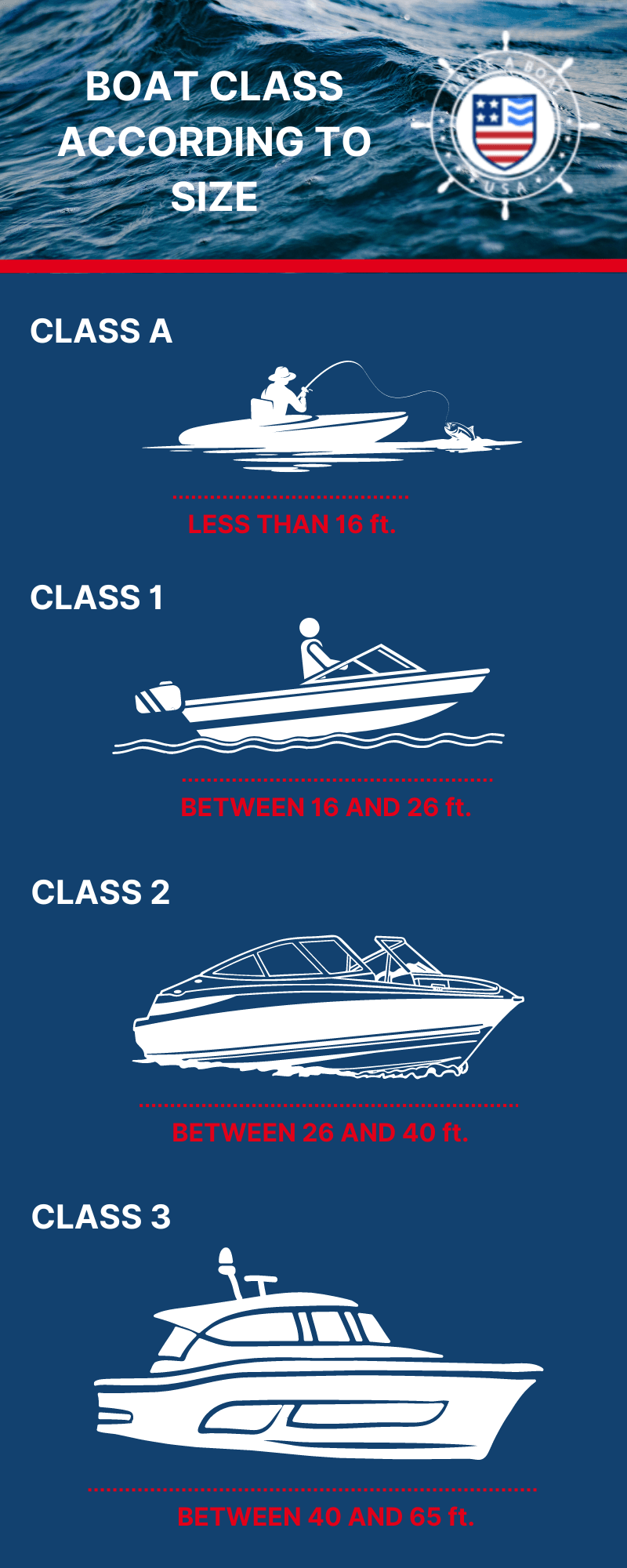
How to measure your boat
You can measure your boat along its centre line from bow to stern, not including any extra attachments like swim platforms. Check out our page outlining the parts of a boat to help you make an accurate measurement.
Class A: Boats measuring less than 16 feet
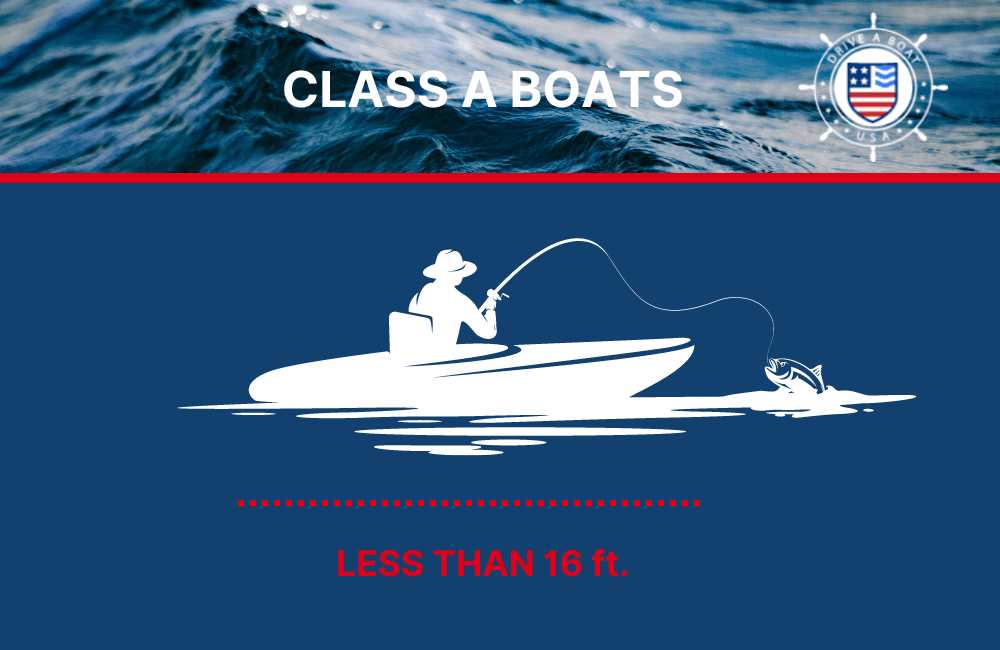
This class includes small fishing boats, canoes, dinghies, personal watercraft and rowboats. To operate this class of boat safely, you need to have:
- Personal flotation devices (PFD) for each person on board or being towed on water skis, etc.
- A bell or whistle
- Visual distress signals (for certain bodies of water) for night-time use
- A fire extinguisher (depending on several factors)
- Ventilation
- A back-fire flame arrestor
Class 1: Boats measuring between 16 and 26 feet

This class includes pontoon boats, jet boats, aluminum fishing boats, smaller deck boats and ski boats. To operate this class of boat safely, you need to have:
- One approved Type I, II or III personal flotation device (PFD) for each person on board or being towed on water skis, etc. and one throwable Type IV device
- Visual distress signals for day and night-time use
Class 2: Boats measuring between 26 and 40 feet
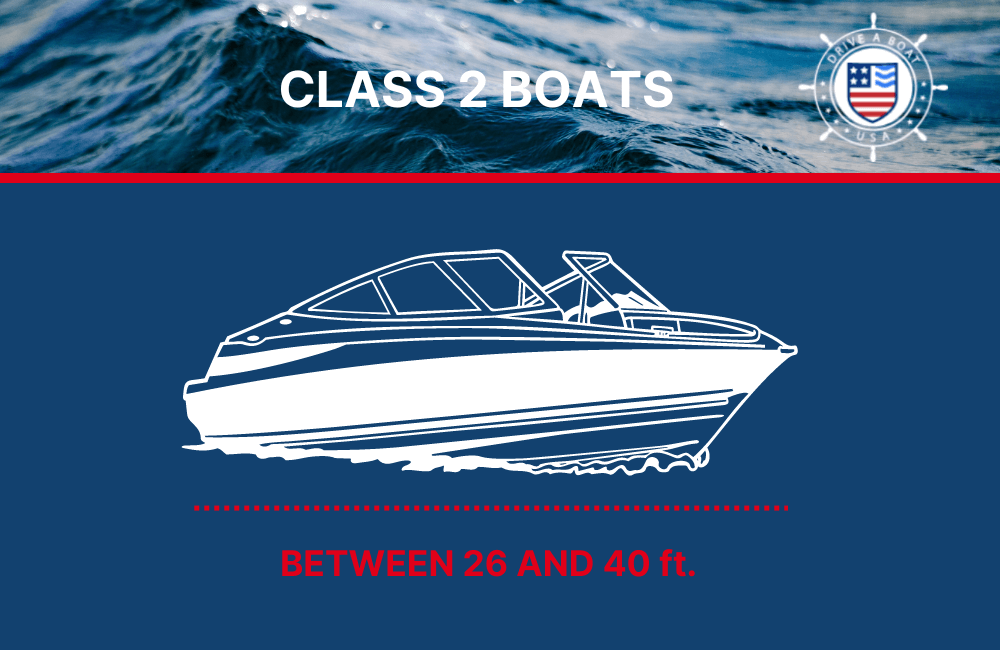
This class includes cabin cruisers, trawlers, sail boats, bowriders and runabouts. To operate this class of boat safely, you need to have:
- A bell or whistle that is audible for 1 nautical mile
- 2 fire extinguishers
Class 3: Boats measuring between 40 and 65 feet
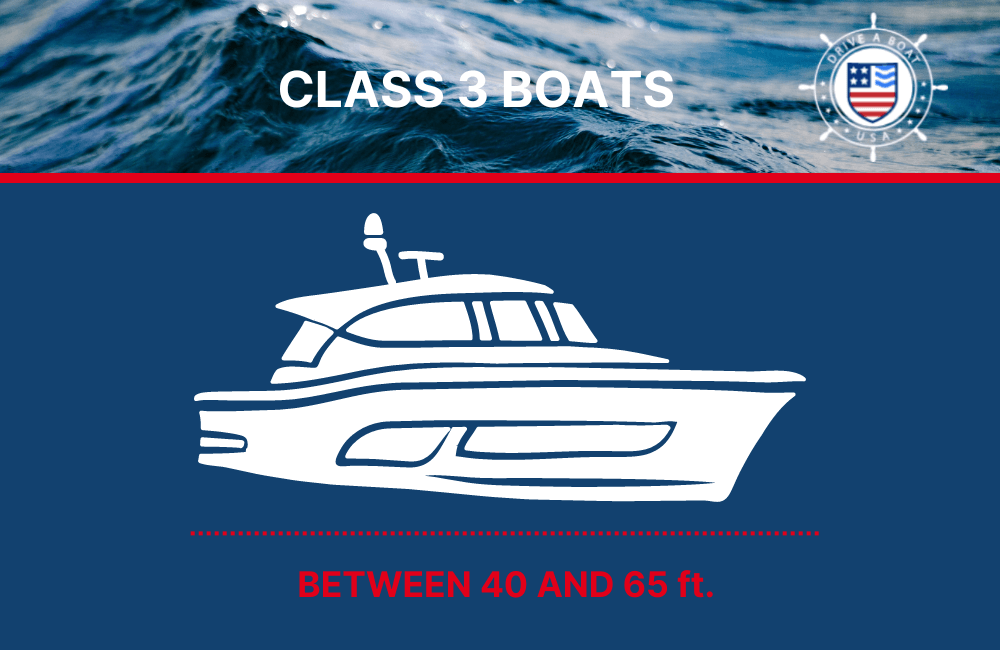
This class includes yachts, sport fishers, catamarans, sail boats and go-fast boats. To operate this class of boat safely, you need to have:
- 3 fire extinguishers
Remember that there could be some variations in the specific type of equipment you need, even within these categories. The best way to be certain that you are prepared to go out on the water is to get your official online state approved boating license .
Learn how to equip your boat with Drive a Boat USA
Whether your boat falls into Class A, 1, 2, or 3, you are responsible for keeping the right safety equipment on board at all times.
Learn what you need to know to enjoy safe and successful boating adventures, including how to drive a boat , from Drive A Boat USA.
Contact us today to earn your official state-approved boating license and take to the water!
- USA Boating
Latest Posts
- Everything You Need to Know About Safe Boating with Dogs
- All About Vessel Safety Checks (VSC) in the U.S.
- Common Causes of Boat Fires
- Tips and Tricks for Docking Your Boat
- Diver Down Flag: What It Looks Like and When To Use It
- August 2024
- February 2024
- December 2023
- October 2023
- September 2023
- January 2023
- November 2022
- Get certified now
- Replacement California Boater Card

What You Need to Know Before Applying for a Cuba Online Visa

Discover the Ultimate Freedom: Exploring Americas Hidden Gems on Two Wheels

Silent Witnesses: Visiting Key Sites of 1940s Conflict

Explore the Best of Perth with ibis Styles East Perth Accommodation

Snowfall In Manali: A Saga Of Romance Or Horror? Manali Winter Travel Guide

What Is The Best Time To Visit Kedarnath? (Brief Travel And Weather Guide For You)
Sorry, but nothing matched your search " ". Please try again with some different keywords.
A Beginner’s Guide To Understanding Yacht Types And Sizes
Feb 13, 2023
Travel Guides
When it comes to buying a yacht, there are many different factors to consider.
One of the most important is understanding the various types and sizes of yachts available on the market. With so many options to choose from, it can be overwhelming for a first-time yacht buyer.
This beginner’s guide will help you understand the different types of yachts and their sizes, so you can make an informed decision when buying your first yacht .
Before we dive into the different types and sizes of yachts, it’s important to have a good understanding of what is available on the market. To get started, check out a list of yachts for sale in various locations . This will give you an idea of the types of yachts that are available and their prices.
Yacht Types
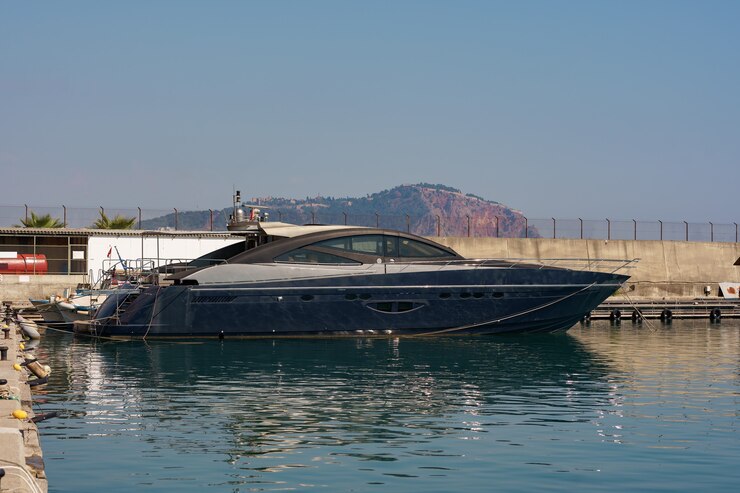
1. Motor Yachts
Motor yachts are powered by engines, and they are designed for luxury cruising. They come in a variety of sizes and styles, ranging from smaller, more intimate vessels to larger, more spacious yachts that can accommodate several guests.
2. Sail Yachts
Sail yachts are powered by the wind and are perfect for those who want a more adventurous boating experience. They are typically larger than motor yachts and offer more space for guests to relax and enjoy the scenery.
3. Catamarans
Catamarans are two-hulled vessels that are known for their stability and comfort. They offer spacious cabins, large outdoor areas, and plenty of room for guests to relax and enjoy the surroundings.
4. Power Catamarans
Power catamarans are similar to catamarans, but they are powered by engines. They are perfect for those who want the stability of a catamaran, but with the speed and convenience of a motor yacht.
5. Trawlers
Trawlers are designed for long-distance cruising and are known for their spacious interiors, comfortable cabins, and excellent fuel efficiency. They are perfect for those who want to explore distant destinations and enjoy extended periods at sea.
Yacht Sizes

A. Small Yachts
Small yachts are typically less than 40 feet in length and are perfect for short trips and intimate gatherings. They are ideal for those who want a simple, low-maintenance vessel that is easy to handle.
B. Mid-Size Yachts
Mid-size yachts are typically between 40 and 80 feet in length. They offer more space and amenities than small yachts, and they are perfect for those who want a comfortable and spacious vessel for extended trips.
C. Large Yachts
Large yachts are typically over 80 feet in length and offer an unparalleled level of luxury and comfort. They are perfect for those who want the ultimate boating experience, with spacious cabins, large outdoor areas, and top-of-the-line amenities.
Perks Of Buying A Yacht
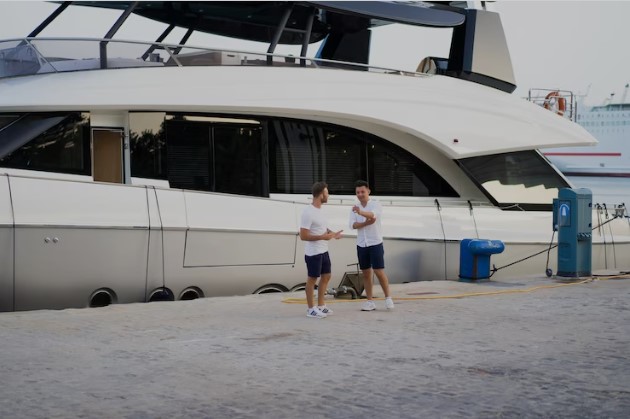
1. Freedom and independence
With a yacht, you have the freedom to travel to any location you choose and set your itinerary. You have the independence to spend time on the water and explore new and exotic destinations.
2. Privacy and exclusivity
Yachts offer a level of privacy and exclusivity that is difficult to find on land. You can escape the crowds and enjoy your own space, away from the hustle and bustle of everyday life.
3. Luxury and comfort
Yachts are designed for luxury and comfort, with high-end amenities and spacious living quarters. You can relax in comfort and style, and enjoy all the amenities you would expect from a five-star hotel.
4. Adventure and excitement
Owning a yacht opens up a world of adventure and excitement. You can go fishing, diving, and exploring, and experience new and exciting destinations.
5. Increased social status
Owning a yacht is often seen as a symbol of success and social status, and can be a great way to network and make new connections.
6. Investment Opportunity
Yachts can also be a wise investment, as they often hold their value over time and can generate rental income if you choose to charter your yacht.
7. Quality family time
Spending time on a yacht can provide quality family time and create unforgettable memories. It’s a great way to bond and connect with loved ones while experiencing new and exciting destinations.
There are many beautiful places you can visit on a yacht, depending on your preferences and interests.
Listed Below Are Some Of The Destinations That Are In High Demand:

A. Mediterranean
The Mediterranean is one of the most popular yacht destinations in the world, offering stunning scenery, warm weather, and a rich cultural heritage. You can visit countries like France, Italy, Spain, Greece, and Turkey, and experience their unique history, architecture, food, and wine.
B. Caribbean
The Caribbean is a popular destination for yacht enthusiasts, offering crystal-clear waters, white sand beaches, and a warm and relaxed atmosphere. You can visit islands like the Bahamas, Barbados, Saint Lucia, and the Virgin Islands, and enjoy activities like snorkeling, diving, and island-hopping.
C. Maldives
The Maldives is a breathtaking destination for yacht enthusiasts , offering a remote and unspoiled environment, with pristine beaches, vibrant coral reefs, and abundant marine life. You can explore the atolls, relax in the sun, and enjoy the tropical paradise that is the Maldives.
D. South Pacific
The South Pacific is a popular destination for yacht enthusiasts, offering a remote and exotic environment, with lush tropical landscapes, turquoise waters, and abundant marine life. You can visit countries like Fiji, Tahiti, and the Cook Islands, and experience their unique culture, history, and natural beauty.
E. Thailand
Thailand is a popular destination for yacht enthusiasts, offering stunning beaches, tropical landscapes, and a rich cultural heritage. You can visit the famous islands of Phuket, Koh Samui, and Koh Phi Phi, and experience their stunning scenery, vibrant nightlife, and tropical paradise.
When it comes to buying a yacht, understanding the different types and sizes of yachts is essential. From small and intimate vessels to large and luxurious yachts, there is a type and size of yacht that is perfect for everyone. With this guide, you will be well on your way to making an informed decision when it comes to buying your first yacht.
- Travel To Turkey
- 12+ Best Hamilton Island Restaurants: Must Visit In 2023!
- Top Luxury Escapes Bucket List Ideas For Wanderlust Jetsetters
- buying a yacht
- convenience of a motor yacht
- first-time yacht buyer
- luxury yacht
- luxury yacht charter
- sizes of yachts
Share on Social Media
Arnab Day is a passionate blogger who loves to write on different niches like technologies, dating, finance, fashion, travel, and much more.
Leave a reply cancel reply.
Your email address will not be published. Required fields are marked *

Skydiving In India: Best Places To Sky Dive In India!

7 Irresistible Reasons To Make California Your Next Vacation Destination

Shopping Tips To Remember While Traveling

Top Five Treks in Nepal
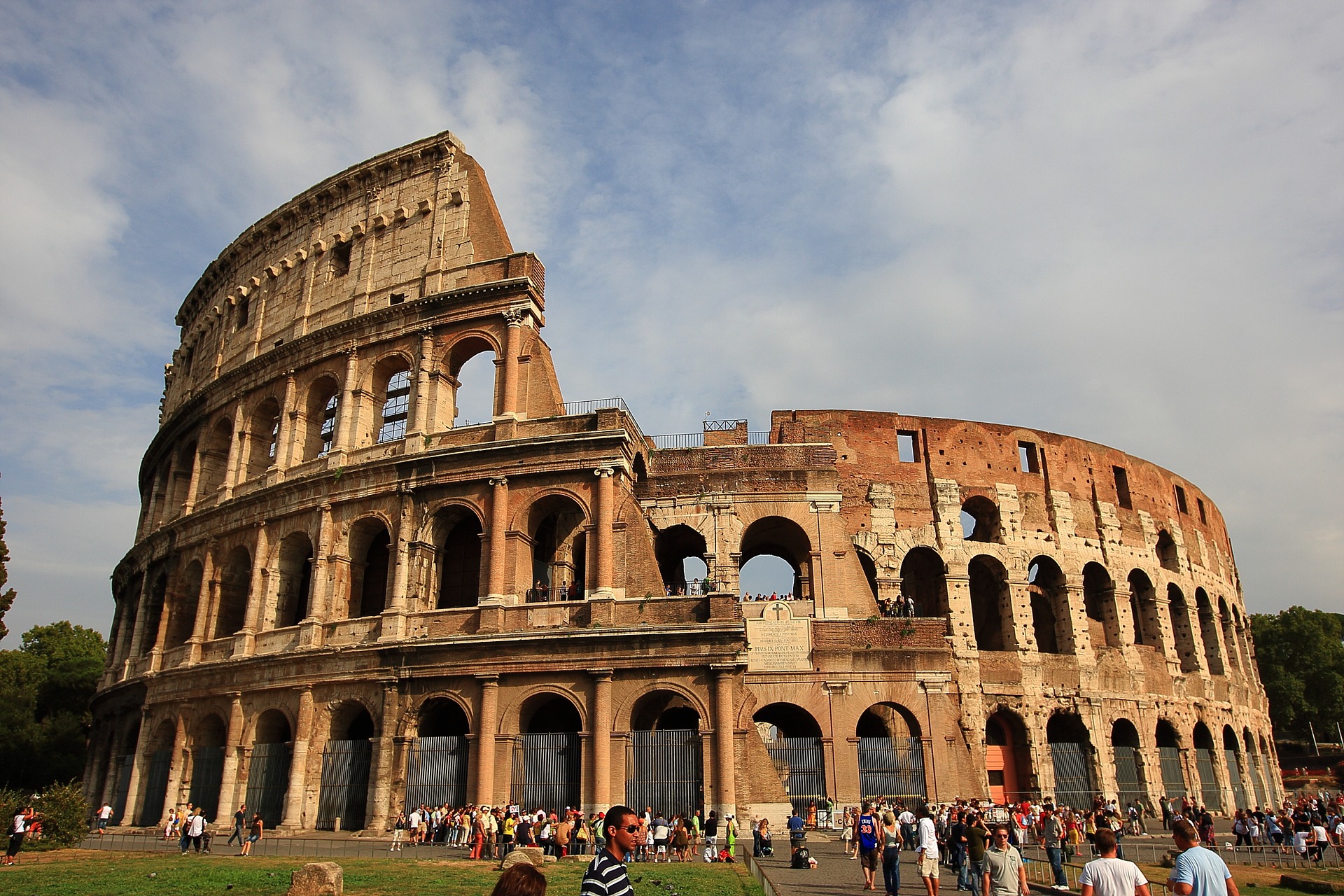
The New Seven Wonders of the World

10 Famous Temples in South India for a Spiritual Journey

Top Sahara Desert Countries You Should Visit
- Articles and Guides
Types of Yachts: An Overview
17th feb 2023 by carrie reed.

From small yachts to superyachts, many luxurious vessels are available for purchase on the market today. Each type of yacht has unique features that set it apart from the other types, so a certain yacht style might suit you better than another. To make sure that you are looking at the right one for you, you will need to know how to distinguish the different types of yachts from each other.
While there is no set definition that specifically sets yachts apart from other vessels, they are generally understood to be larger than average (at least 40 feet long or bigger) with a galley, a head, and cabins with sleeping quarters. Yachts usually have powerful diesel motors that can handle cruising, runs to distant fishing grounds, and watersports. Yachts can also be classified by numerous factors, including size, amenities, and method of propulsion.
Types of Yachts
There are four main categories of yachts: motor yachts, sailing yachts, motor sailers, and cruisers. Let's take a look at each one.
Motor yachts
A motor yacht is propelled with the use of a motor or, more commonly, multiple motors. As the most common type of yacht available today, motor yachts are built for entertainment with spacious social interaction areas and luxurious accommodations. Buyers often choose motor yachts because of their suitability for extended cruising ventures, entertaining large groups of guests, and charter trips.
Sailing yachts
A sailing yacht uses sails as its primary means of propulsion. While these yachts also have motors on board, they’re usually used only when there is not enough wind to propel the craft, when docking, or when operating in heavily trafficked harbors or channels. Sailing yachts are appealing because of the quiet and environmentally friendly way they operate, as well as their essentially unlimited range. Sailing yachts generally have a lower profile and due the the shape of the hull, less onboard space than other types of yachts.
Motor sailers
Motor Sailers are a hybrid between a motor yacht and a sailing yacht. They generally use a motor as the primary form of propulsion, but also have sails that can be used when the weather conditions are right. Though less popular than the other types of yachts there are subcategories of motor sailers such as the gulet (for information see What is a Gulet? What is it like to charter one? ), and there are also some catamaran motor sailers.
Cruiser yachts
Yacht styles that do not quite fit into the previous categories are often called cruiser yachts or express cruisers. These yachts are generally modern looking, with sleek, streamlined hulls and open cockpit areas. They are on the smaller side for yachts, typically no more than 60 or 70 feet long, and are usually powered by twin diesel engines.
Types of Luxury Yachts
A luxury yacht is generally understood to be a yacht that is built with the latest in modern technology and features high-end finishes and materials. The word "luxury" can be used with any type of yacht that is exceptionally well-appointed, but some types of yachts are considered to be more luxurious than others. Let's take a look at what they are.

Classic luxury yachts
Today's classic luxury yachts are designed to emulate the grace and style of the classic yachts of yesteryear while incorporating the latest technology in a non-intrusive way. These yachts tend to have large private cabins with full baths and Jacuzzis, spacious social areas that can accommodate many guests, and lavish accommodations featuring air conditioning, high-speed internet access, and expansive entertainment systems.
Mega luxury yachts
Mega luxury yachts are private yachts that can be hundreds of feet long and are crafted specifically to carry large numbers of family and friends in lush accommodations. They feature vast open areas for sunning and socializing, multi-level entertainment and relaxation options, and VIP staterooms with private en suite heads. Many have additional special features, such as saunas, gymnasiums, and spas.
Types of Small Yachts
Small yachts, also called sport yachts, are vessels that are less than 60 feet long and are designed to accommodate no more than a dozen people at a time. These yachts often have sleek designs and may be used for fishing trips, offshore excursions, and water sports. Like the term "luxury," the word "sport" can be applied to just about any style of yacht, but some types seem to fit the category better than others. More information: Small Luxury Boats with a Difference .

Yacht Sizes
You can find yachts in three size categories: yachts, superyachts , and mega yachts. While you can find some variation in how these terms are used, yachts are generally classified as being up to 100 feet long. Superyachts are between 100 feet and 200 feet long. Mega yacht is the term used for any yacht that is more than 200 feet long.
Yacht Categories
Yachts are often categorized by their notable features, with the terms "sport" or "luxury" added to describe their level of opulence. Here are some of the most popular yacht categories.

Catamaran yachts
This type of yacht is often made of fiberglass and has two hulls with an open space in the middle for greater stability and a smoother ride. They are available in both sailing and power varieties.
Flybridge yachts
Flybridge yachts are built with a spacious deck and living space atop the main cabin, called the flying bridge or flybridge. The layout of the flybridge may be open or fully enclosed with climate control. They also typically have a hardtop and a sizable seating and/or lounge area.
Sportfish yachts
Also known as sport fishing yachts , these yachts are built for speed and durability, making them great for fishing trips and sport fishing tournaments. They typically have a large cockpit and ample storage space to accommodate anglers on the water for long periods of time. Sportfish yachts may come equipped with outriggers, fishboxes, fighting chairs, and other fishing features.
Expedition yachts
Expedition yachts are designed for adventure, with a deep displacement hull to enhance stability and comfort during long trips. They are designed for passengers to remain safe and comfortable through long oceanic voyages, and tend to have extended range and plenty of accommodations.
Written By: Carrie Reed
More from: Carrie Reed
Related Articles and Guides
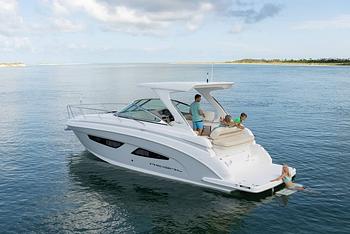
6th Sep 2024
The Best Mini Yacht Brands for Cruising and Luxury
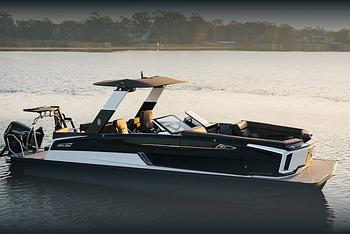
16th Aug 2024
Best Luxury Pontoon Boat Brands Have it All: Glamor, Speed, Fishing, Waterslides...
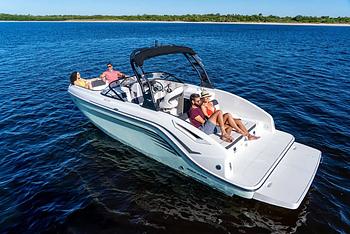
10th Aug 2024
Deck Boat vs. Bowrider: Which Runabout is Best?

19th Jul 2024
The World’s Best Yacht Brands

- Explore Rightboat
- Boats for Sale
- Boating Articles
- Buyers Guide
- About RightBoat
- Sell Your Boat
- Boat Selling Advice
- All manufacturers
- All categories
- Are you a broker/dealer?
- Learn more about the Rightboat:HUB
Enter your email to keep up to date with the latest news
Join for free
Sign up now for free and discover how easy it is to keep up to date with THE latest boats for sale. Find your right boat, and tailor your voyage to finding your next boat.
Benefits of becoming a member:
- Set up tailored alerts
- Personalise your experience
- Download full specifications and broker details
- Keep tabs on your favourite boats
Are you a broker? Join as a Broker
Rightboat - join for free.
Do you have an account already? Login
Save this search
Save your search and receive new boats in your email..
You can unsubscribe from your alerts whenever you like. By pressing the button you accept the Legal Terms and conditions
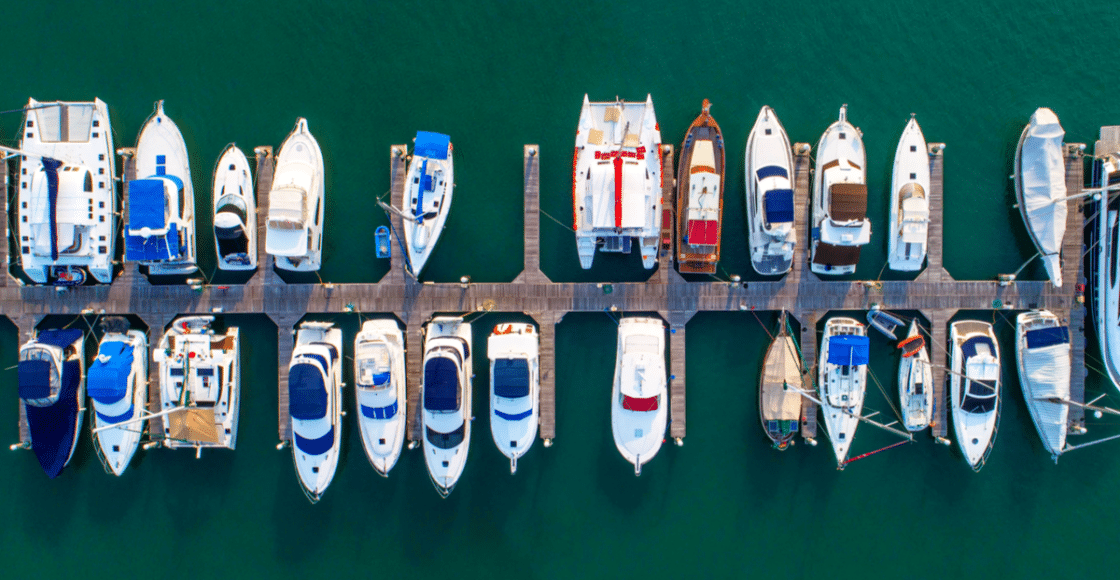
Types of Boats: A Complete Guide

Table of Contents
Last Updated on July 16, 2024 by Boatsetter Team
From canoes to the Maltese Falcon and beyond, private boats range from eight feet to megayachts, hundreds of feet in length. Used for fishing, cruising, living aboard, and as a means to get away from the beaten path, boats have been a part of the lives of humans since one decided a ride down the river on a log was pretty cool.
Boat designs have come a long way since the advent of the first dugout, but one thing remains the same. People like boats and have all manner of uses for them.
Rowboats to expedition yachts offer their owners the same thing: a day on the water pursuing a dream. Whether that dream is hooking a catfish at your local lake or chasing gamefish across the globe, people will find a way to get on the water.
In this article we’ll explore the numerous types of boats available and help you decide which one’s right for you.
How many different kinds of boats are there?
There are many types of boats, and their hull types include single and multihull, power, and sailboats.

Types of boats include:
- Aluminum fishing boats
- Fishing pontoon boats
- Inshore Fishing boats
- Read more about the best sailboats for lakes , and the best sailboats for beginners .
- Read more about the most affordable pontoon boats and luxury pontoon boats
- Hydrofoil boats
- Read more about affordable center console boats
- Luxury center console boats
- Read more about affordable bay boats
- Mega Yachts
- Expedition Yachts
- Dinghies sail/power
- Day sailors
- Coastal cruising sailboats
- Ocean-going sailboats
- Pontoon Boats
- Cabin Cruisers
- Convertible
- Cruiser racer
- Cuddy cabin
- Daysailer & weekender
- Dual console
- Express cruiser
- Fish and ski
- Inflatable outboard
- Motorsailer
- Motor yacht
- Offshore sport fishing
- Performance
- Performance fishing
- Rigid inflatable
- Saltwater fishing
Boats range in size from as few as seven feet up to hundreds of feet in length and have classes that fit within their types. This information can help you understand how you can use a particular kind of boat.
Relevant boat types comparisons
- Small catamarans VS Pontoon boats
- Pontoon VS Deck boats
- Catamaran VS Monohull
- Yacht VS Boats
- Aluminum VS Fiberglass boats
Read more about the best boat types
- Best boat brands & manufacturers
- Best ocean boats
- Best liveaboard boats
- Best boats for beginners
- Best family boats
- Most affordable cheap boats
What are the four classes of boats?
Separating boats into classes helps Federal and State authorities make it easy to determine how a particular boat is to be used. For example, a boat’s class determines the number of passengers it can carry. Thus, it also determines the number of flotation devices onboard for each occupant and other safety equipment necessary. These determinations are based on the class of boat, which puts your craft into a size range.
- Class A less than 16 feet
- Class 1 16 to less than 26 feet
- Class 2 26 feet to less than 40 feet
- Class 3 40 feet to less than 65 feet
- SRV (small research vessel) Boats of 65 feet in length, yet less than 300 gross tons fit this category.
What are the Categories of Boats
The European Union enacted the Recreational Craft Directive in 1998. It affected the designation of boat categories for boats built and sold there.
These design standards are for most boats that range in length from 8 to 79 feet, measure the seaworthiness of a vessel, and indicate a boat’s ability to manage certain wave heights and wind conditions.
A boat’s ability to range afar or stay near shore is determined by its hull strength, freeboard, stability, deck drainage, and reserve buoyancy. Any other criteria that might affect their seaworthiness are also noted when categorizing boats.
Category A – Ocean Class Boats:
Boats in this class are generally self-sufficient and designed for extended cruising into winds over Force 8, on the Beaufort scale (+ 40 Knots). They are built to take wave heights over 13 feet and are conditions that are not from a hurricane or typhoon.
Category B – Offshore Class Boats:
This class includes boats that operate offshore in Force 8 with winds up to 40 knots and seas up to 13 feet in height.
Category C – Inshore Class Boats:
This class encompasses boats that operate on lakes, rivers, coastlines, and large bays and includes boats that can stand up to Force six winds, 27 knots, and seas up to seven feet in height.
Category D – Coastal water, inland, and sheltered waters:
Boats in this class include those built for rivers and small lakes and are designed to stand up to Force 4 winds (11 – 16 knots) and wave heights of a foot and a half (18 inches).
Not all boats in the United States are built to these standards. However, you can rent a private fleet of boats in many areas of the world through Boatsetter. For example, these standards apply to many of the rentals in Europe. They also apply to vessels built in the United States by European manufacturers.
Boat classification can affect boat types, and knowing the capability of a boat based on its classification gives boat owners a better idea of the level of seaworthiness before setting off for the Caribbean.
What’s the difference between a ship and a boat?
An adage claims a ship can carry a boat, but a boat cannot take a ship. However, it is not quite that simple.
Many of today’s boats carry another boat. You can often see less than thirty-foot boats carrying kayak, or dinghy boats. Taking a small boat on your larger boat can help you get ashore in areas without dockage. However, does it make your thirty-footer a ship? No, it probably doesn’t; however, it expands its usability.
Boats for Lakes
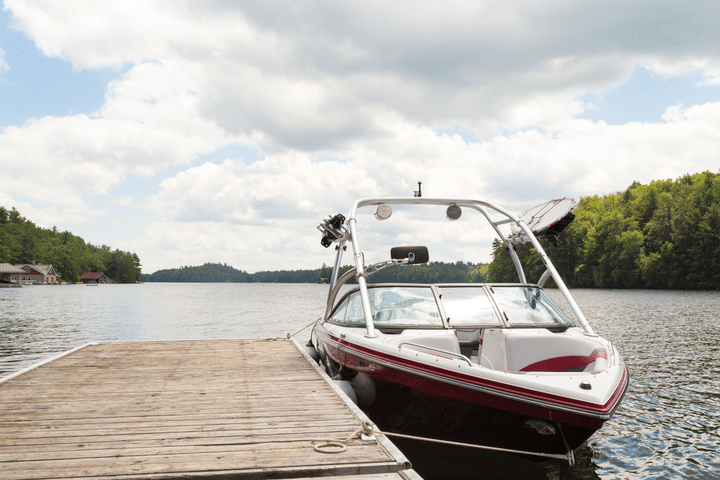
Lakes come in all sizes, as do the boats one needs to ply their waters. For example, suppose you are a boater whose playground is Lake Michigan. In that case, you will need a different boat than a boater who fishes Lake Okeechobee .
Small and shallow lakes don’t require big boats for your fishing and boating adventures. Bass boats, pontoon boats , outboard skiffs, and even rowboats are suitable for your needs.
However, if you are on a big, deep-water lake, your boat needs may be more similar to boats that spend time on the ocean . The deeper water of lakes allows for bigger waves and the need for bigger boats.
If you are a fair-weather boater, any small boat will do on the big lakes and the small. However, if you are a boater who wants to go fast, even if there’s a gale blowing, you will need more than a 25-foot powerboat, no matter how many outboards you strap to its transom .
Boats for Oceans
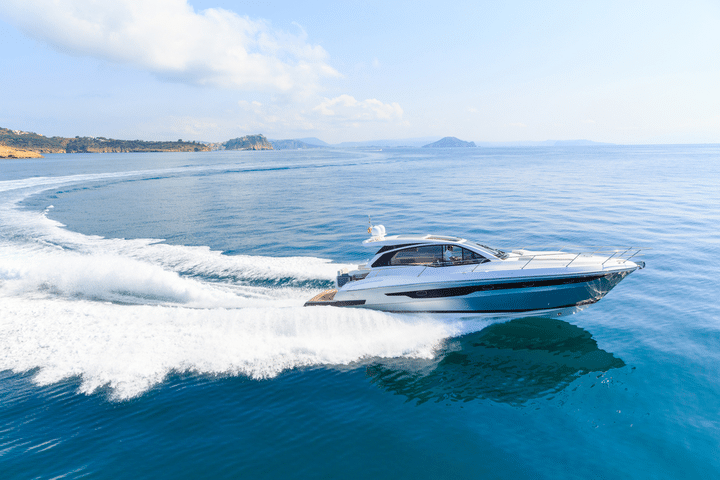
A boat of fewer than 12 feet crossed the Atlantic in 1987 , and its captain lived to tell about it. However, adventures such as that are
outside the desire of most boaters.
Power and sailboats are built for ocean-going, and most are over 30 feet in length. These ocean-going vessels include trawlers, sailboats, motorsailers, catamarans , game fisher boats, expedition yachts, and mega yachts.
Ocean-going boats usually have high sides and bows, deep V, or displacement hulls. Gas or diesel engines or sails can power them.
However, many offshore fishing boats are open center-console boats with multiple high-powered outboard or inboard engines. This abundance of power, usually on boats over 30 feet in length, can get them quickly to their fishing grounds. It also gives them the speed to outrun approaching storms if they need to make a run for home.
Specialty Boats for shallow water and big wakes
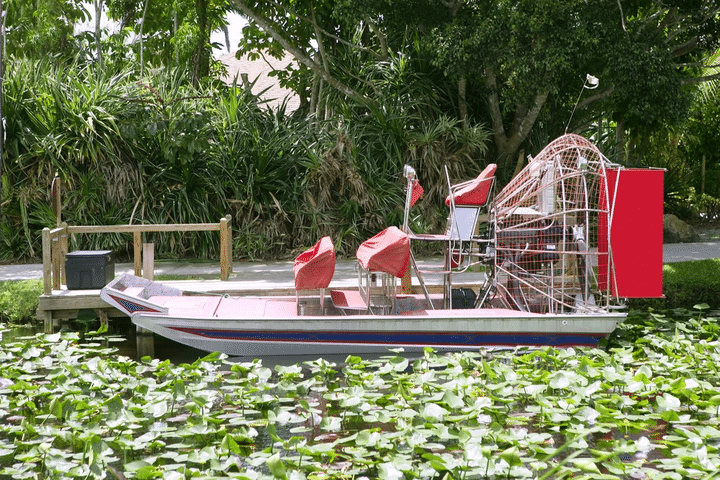
There is a particular class of boats designed for the shallows of lakes, rivers, and marshlands built to get into water that isn’t much more than ankle-deep. These vessels include airboats, flat boats, and johnboats with Gatortail mud motors.
They enable their owners to ease into backwaters where others can’t go in search of a prize catch. As a result, they are perfect boats for boaters who live near marshlands, swamps, rivers, and lakes.
Wake boats are designed to bog down and throw up a wake big enough to surf upon. They manage this feat by filling their hulls with water, making them very heavy, then plowing all that weight through the water with a powerful engine. The result is surf on demand.
What type of boat is best for you?
Only you know what you want and what you would like to do while on the water. Or, you may have an interest in boating and would like to explore its every facet. With Boatsetter , you have access to the largest private fleets of boats, yachts, and small ships available in the world. Find the right boat rentals now and start exploring all the available boat types.
From jet skis to megayachts, the Boatsetter fleet delivers. Boat owners who live near you or in locations you would like to visit have their boats ready and awaiting your arrival. All you need to do is find the boat you want to rent, where you want to rent it, and set a date. So, whether you opt for a bareboat adventure or the luxury of a captain on your cruise, a Boatsetter rental can open your horizons to every type of vessel boating has to offer.

Boatsetter empowers people to explore with confidence by showing them a world of possibility on the water. Rent a boat, list your boat, or become a Boatsetter captain today.
Browse by experience

Explore articles

6 Best Beach Towns in Georgia for Boaters to Explore

Boatsetter co-founder, Andy Sturner, honored by Millennials Project!

3 Easy Boat Trips to Cap-Off the Summer in Seattle

Seabin Project for Cleaner Oceans | #MindYourWake Series
- Seller Market Analysis
- Trade Your Yacht
- Sold Yachts
- We Buy Boats
- Exclusive Listings
- Yachts for Sale
- New Yacht Builds
- Nautor Swan Yachts
- Sichterman Yachts
- Luxury Yacht Charters
- Search Charter Yachts
- Charter Management
- Luxury Events
- Team Members
- Boat Show Events
- North Report Magazine
- Testimonials
- +1.954.900.9988
Blog | Owner’s Guide to Yacht Classification
Yacht classification is a system used to categorize yachts based on various factors such as size, construction, and intended use. The specific classification categories and requirements can vary between different yacht classification societies, but some common classifications include:
- Pleasure Yacht: A yacht intended for leisure use, typically not engaged in commerce.
- Charter Yacht: A yacht that is available for hire for pleasure use, also known as commercial yacht.
- Large Yacht: A yacht that exceeds a certain size or gross tonnage.
- Small Commercial Yacht: A yacht that is used for commercial purposes but does not exceed a certain size or gross tonnage.
- Passenger Yacht: A yacht that is used to carry passengers for hire.
- Workboat: A yacht or vessel intended for work-related use, such as a survey vessel, cable layer, or other specialty use.
- Ocean Going: Yachts that are able to make ocean passages and are built and equipped to meet the requirement of such voyages
- Coastal: Yachts that are intended to operate in coastal and sheltered waters and meeting less stringent requirement than ocean going yachts.
The main differences between yacht classification societies are their specific rules, regulations, and requirements for yacht classification. While many societies have similar overall goals of ensuring that yachts meet certain standards of design, construction, and maintenance, they may have slightly different interpretations of these standards and how they should be applied.
Some societies may have stricter or more detailed rules and regulations than others. For example, one society may have more stringent requirements for fire protection, while another society may place more emphasis on stability calculations.
Another difference is the type of yachts they cover and the services they offer. Some societies focus primarily on pleasure yachts, while others also cover commercial yachts and workboats. Societies may also offer different levels of classification, such as “unrestricted” or “restricted” class, and this might vary depending on the intended use of the yacht.
Lastly, some societies have a more global presence than others, or have more experience or expertise in certain types of yachts or regions. This can be important for yacht owners who plan to take their vessel to different parts of the world and may need to comply with different regulations in different countries.
In short, yacht classification societies are similar in their overall goals, but they can have different rules, regulations, and requirements for yacht classification, different services and different areas of focus. Yacht owners should research and compare different societies to determine which one is the best fit for their specific needs and intended use of the yacht.
There are several yacht classification societies that provide certification and inspection services for yachts and other small vessels. Some of the most well-known include:
- American Bureau of Shipping (ABS)
- Bureau Veritas (BV)
- Germanischer Lloyd (GL)
- Lloyd’s Register (LR)
- RINA (Registro Italiano Navale)
- Det Norske Veritas (DNV) now known as DNV GL
These organizations are responsible for ensuring that yachts and other vessels meet certain standards of design, construction, and maintenance, and they issue certificates of compliance to vessels that meet these standards. They also conduct periodic inspections to ensure that vessels continue to meet these standards over time. Some of them also provide additional services such as collision avoidance, navigation and stability calculations and other specialized services.
Recent Stories
Lisbon, portugal: the ultimate superyacht stop for food, wine, and adventure, experience the south of france with a luxury yacht charter on m/y soul mate.

Talk to us Contact Our Team
I understand that by signing up I agree with 26 North’s Privacy Policy .
Welcome aboard!
We have added you to the newsletter.
We have received your information and an agent will get back to you ASAP
Sign up for Yoga On the Docks Tuesdays at 8 AM
We have received your registration. See you on the docks!
Ita Yachts Canada
Brokerage / Courtage
Understanding the Classification of Yachts A, B, C and D
Understanding the Classification of Yachts A, B, C and D:
Since 1998, Europe (EEC) classifies yachts according to 4 categories A or B or C or D and this is a law. In order to sell a boat in the large territory of the EEC, it must be classified with a plate that mentions its classification and it must be clearly visible inside the boat, usually near the helm.

At first glance, it sounds very good when you hear class A, but what is it really, what are the differences, is it necessary to acquire a class A…
The brokers at ItaYachtsCanada have written an article on this subject in the past ( click here ), but here are the important characteristics to know about the subject.
The classification allows you to know in which kind of sea intensity you can safely venture, that is to say, taking into account the wind and the wave height in reference to the Beaufort index.
(At the end of this text, there is an explanation of the classes according to the Beaufort index).
Let’s say we focus on class A and B, on the major differences.
First of all, the differences are not very visible to the naked eye or it takes a trained eye to see them.
Depending on the type of water you plan to sail and if the weather guides you on each trip, a B class is also a very good choice.
Of course, you must have all the required safety equipment on board.
Ideally, a boater should always sail in rather peaceful conditions, taking into account the weather first. We always say that boating is fun, so stay away from difficult sailing situations. (Ideally, always with a Beaufort index of 6 and less, ideally a Beaufort index of 4 and less).
Many manufacturers have retained the parameters of the B class to build their boats, mainly for reasons of production costs and that boaters in general do not care much about these characteristics.
The problem is how to differentiate between the vast range of B class boats, how to distinguish those that are closer to an A class (B +) from those that are built as (B -).
How to find your way around, especially for a layman…

It is important to know that some manufacturers build their boats with an A approach, but without respecting all the mandatory specifications to be classified A.
Here are some guidelines to quickly see if the manufacturer has done things right.
– Inspect the portholes and closing mechanisms (Plastic or Metal)
– The presence of numerous drains to evacuate water (at the fly and cockpit), it is essential to be able to evacuate any water accumulation quickly.
– Height of the freeboard.
– Engine access hatch, well insulated and secured for water leaks.
– Bilge pumps (number, size and capacity)
– Mechanism to pump water from the engine room massively (e.g. possibility to use the engine water pumps with a joystick)
– The center of gravity of the boat is well balanced (rather low).
Hull joints, a very low center of gravity, excellent weight distribution, electrical system (24 V), are also part of the certification criteria especially for A boats, but difficult to assess for a yachtsman. It is possible, but in a summary way.
The CE classification allows to differentiate yachts according to certain criteria present, we are talking mainly about structural strength, integrity of essential parts of the hull, reliability of propulsion, steering systems, power generation and all other features installed on board to help ensure the essential services of the yacht.
Therefore, it is important to understand that a Class A yacht is built to a much higher standard than a Class B. This is not reflected in the luxurious appearance of the boat.
What you have to remember is that the major enemy for a boat, besides a fire, is water infiltration on board which can destabilize the behavior of the boat, cause a stop of the engines, major electrical problems, in short which can quickly put the boat out of use and/or out of control.
A classification body such as RINA (see list at the end of this text) has been checking the activities of builders and classifying yachts for over 20 years.
If the boat is sold in the European Community, the classification is mandatory and must be visible near the cockpit. This same classification is not present when the boat is intended for North America or very rarely.
Do not hesitate to contact a professional broker, he will be able to guide you according to your needs, your criteria and especially the places of navigation.

As the CE classification is not always displayed when the boat is destined for the North American market, here are some references on this subject based on the most recent data available (subject to change without notice):
P.S. Let’s mention that as a general rule yachts over 80 ft are Class A, but according to the rules in place, the classification is no longer mandatory or mentioned beyond 79 ft.
Class A (yachts over 50 ft):
BEST KNOWN MODELS :
Ferretti 500, 550, 670 and up
Pershing : 7X and up
Azimut 62, 64, 66, 68 Fly and up
Azimut S8 and up
Azimut Magellano : the whole range
Sunseeker Sport yacht 65, Yacht 88 and up
Princess yacht 80 and up (TBC)
Marquis Yachts (no longer in production)
Montecarlo MCY 66 and up
Searay L650
Class B (yachts over 50 ft):
Sunnseeker 52 fly, 55 fly , 66 fly, 68 fly, Sport Yacht 74, 76 Yacht
Azimut 50 fly, 55 fly, 60 fly, S6 and all Atlantis
Princess : all yachts under 70 ft
Princess Y72, Y78 and less
Ferretti 580 fly
All Absolute
All Fairline
All Beneteau & Jeanneau & Monte Carlo 52
All Searay except L650.
All Cruisers Yachts
For more information, here is an article published by the brokers at ItaYachtsCanada, click here .
There is also the dry weight which can help determine a quality yacht.
Don’t hesitate to compare yachts of the same size based on dry weight, you may be surprised.
For example, a 52′ yacht that weighs 30,000 lbs empty compared to another one that weighs 60,000 lbs empty, ask yourself some questions.
But be careful, it is more and more difficult to get the manufacturers’ empty weights. They have understood the importance of being rather vague on the subject or of making comparisons more difficult. Indeed, we are talking about LIGHT WEIGHT, which is difficult to measure.
The manufacturer who has confidence in thier boat will have no difficulty in giving a total warranty of at least 12 months, 24 and even 36 months. Please note the difference here between the manufacturer’s warranty and the dealer’s warranty .
Many European manufacturers sell their boats to dealers in America without a warranty. This means that the dealer assumes the full 12-month warranty out of his profit from the sale. The engine manufacturer, on the other hand, honors its own warranty such as Volvo, Cummins, Caterpillar, MAN, MTU, Yanmar. For other major components, it will be up to you to take the necessary steps to have the warranty honored, such as for the generator, the air conditioning, the thrusters, etc…

Therefore, acquiring a boat requires a much more specialized expertise than that of a car! Contact ITA Yachts Canada Inc. to speak with a professional and independent broker with experience in the following markets (Canada, United States and Europe whether the boat is new or used).
MORE INFORMATION.
Here is some more information about the classification, what the law in Europe says about it.

Here are some links to help you understand the Beaufort index in direct relation with the classification of yachts sold on the territory of the EEC:
Click here for the TRANSPORT CANADA website
Click here for an article on Wikipedia (more descriptive with photo).
According to the EEC rules, here is the description:
The classification of vessels marked “CE
CE marked vessels are classified into four design categories according to their ability to cope with sea conditions characterized by wind speed and significant wave height. Depending on the type of navigation practiced, the boater must choose a vessel whose design category authorizes such practice.
– Design Category A: Recreational vessels designed for winds that can exceed force 8 (on the Beaufort scale) and for waves that can exceed a significant height of 4 meters, excluding exceptional conditions such as storms, severe storms, tornadoes and extreme sea conditions or huge waves (these conditions exclude force 10 and following).
– Design Category B: Pleasure craft designed for winds up to and including force 8 and for waves up to and including 4 meters in significant height.
– Design Category C: Pleasure craft designed for winds up to and including force 6 and for waves up to and including two meters in significant height.
– Design Category D: Pleasure craft designed for winds up to and including force 4 and for waves up to and including 0.30 meters, with occasional waves up to and including 0.50 meters.

Vessels in each of these design categories shall be designed and constructed to withstand the parameters of each of these categories, with respect to buoyancy, stability and other relevant requirements, and to have good maneuverability characteristics.
The known classification bodies for the EEC:
RINA (Registro Italiano Navale),
BV (Bureau Veritas),
DNV (Det Norske Veritas),
Germanischer Lloyd,
LR (Lloyd’s Register).

Ita Yachts Canada provides the information in this article in good faith but cannot guarantee the accuracy of the information or the status of the data. It is the responsibility of the reader to instruct their agents or experts to verify and validate the information in this article.
Share this:
Published by Guy Bolduc
View all posts by Guy Bolduc
Leave a Reply Cancel reply
Discover more from ita yachts canada.
Subscribe now to keep reading and get access to the full archive.
Type your email…
Continue reading
- CATAMARAN MOTEUR
- CATAMARAN VOILE
- CENTER CONSOLE
- FISHING BOAT
- SPORT BRIDGE
- ABSOLUTE YACHTS
- CRUISERS YACHTS
- FOUNTAINE PAJOT
- GRAND BANKS
- KADEY-KROGEN
- MOCHI CRAFT
- MINIGHT EXPRESS
- MONTE CARLO
- NORTHERN MARINE
- OCEAN ALEXANDER
- OUTBACK YATCHS
- PARDO YACHTS
- PRESTIGE YACHTS
- SILENT YACHTS
- $1,5 M to $2,9 M
- $3,0 M to $4,9 M
- $5,0 M to $6,9 M
- $7,0 M to $9,9 M
- $10,0 M and more
- UNDER 49 FEET
- 50 to 59 FEET
- 60 to 69 FEET
- 70 to 79 FEET
- 80 to 89 FEET
- 90 to 99 FEET
- MORE THAN 100 FEET
- CENTRAL AMERICA
- PERSIAN GULF
- UNITED-STATES OF AMERICA
- YACHTS REGISTERED UPDATED
- VIRTUAL TOUR 3D
- YACHTS FOR SALE
- IMPORT-EXPORT
- BLOGUES, NOUVELLES ET CONSEILS
- PODCAST VIDEO
Yacht classifications, also referred to as classification societies or class societies the that rules are an integral element of owning a yacht and an important part of maritime safety. These classifications dictate the design, construction and ongoing maintenance of large commercial vessels and superyachts.
The classifications provide highly detailed and technical standards which cover the yacht’s hull, its engines, and key safety systems. Naturally technology is constantly advancing and so new safety features and procedures are frequently evolving to cater for this.

Standard Yacht Types
Yachts are typically segmented based on overall length and how many passengers they can accommodate. The standard yacht classification types are large yachts, sailing yachts, commercial yachts and private yachts.
Commercial yachts are those yachts which engage in commercial activities, i.e charter yachts. These yachts do not transport or carry any cargo and can carry no more than 12 passengers when underway. In contrast, private yachts are typical pleasure vessels used solely for recreational or leisure purposes.
Classification society
Classification societies are organizations which ‘set the rules’ that govern the construction, maintenance, and operation of yachts and vessels. Currently, there are a total of 12 members of the International Association of Classification Societies, of which the main societies involved with yachting are::
- ABS (American Bureau of Shipping)
- Bureau Veritas
- Lloyds Register
- RINA (Royal Institution of Naval Architects)
Classification societies were first started when insurance underwriters Lloyds of London set standards for the ships that they would ensure.
What is a flag state?
A vessel’s flag state is the jurisdiction or nationality under whose laws the vessel is registered or licensed.
The flag state has the authority and the responsibility to create regulations for vessels registered under its flag. These typically involve those relating to the inspection, certification, and issuance of safety and pollution prevention documents for the vessel.
Different flag states may perform inspections on the safety aspects of yachts using their own inspectors or use classification societies or other recognised organization to perform these inspections.
I have written a separate blog post which goes into further detail on Flag States and the importance of choosing the right flag for your yacht.

What is the classification process?
The first step of classification involves the assessment of a yachts design and regular inspections during the construction or conversion of a yacht. Once it is confirmed that all standards have been met, a certificate of classification is issued.
The certificate details the standard met, the intended use for the vessel, and whether the vessel should be used only in sheltered waters. The certificate is aevidence evidence that the yacht has been built too and meets industry standards.
In order to maintain classification regular surveys of the yacht are required. These surveys typically take place every 5 years. These surveys assess things such as the thickness of the hull, possible fractures, and other potential damage. They also consider the condition of electrical systems, machinery and equipment.
Mandatory Classification Certificates
There are a variety of different classification certificates. The number and type of mandatory certificates for a given yacht will depend on its size.
International Tonnage Certificate
This expresses the internal volumes of the yacht in gross tonnes. Unlike displacement tonnage, this does not quantify the weight of a vessel.
Large Yacht Code Certificate
This certificate covers navigational and signaling equipment, life saving appliances, fire protection, means of escape, and manning and crew accommodation. `
Class Certificate
This mainly deals with the yacht’s hull, machinery, electrical equipment, and outfitting.
International load line certificate
This certificate covers the weather tightness of the yacht
Safety Radio Certificate
This certificate only applies if the yacht’s gross tonnage exceeds 300GT. It covers radio communication and distress installations.
MARPOL Annex I Certificate
This certificate only applies if gross tonnage exceeds 400GT and covers the disposal of oil and bilge water
MARPOL Annex IV Certificate
This certificate only applies if gross tonnage exceeds 400GT or if the yacht is certified to carry more than 15 people and covers the disposal of sewage from ships
Marpol Annex V
This certificate covers the disposal of rubbish and applies to all ships
Marpol Annex VI
This is applicable if gross tonnage exceeds 400GT as well as to all main and auxiliary engines with a power exceeding 130kW. It concerns the emissions from mains and auxiliary engines (NOx and SOx). Safety Construction and Safety Equipment
These cover machinery, electrical parts, life saving and navigational equipment for yachts with a gross tonnage above 500GT. International Safety Management Certificate
This only applies to yachts with a gross tonnage greater than 500GT. A certified management company is requested to carry out this service, preparing operational manuals, procedures for drills, and taking care of the maintenance of the yacht and its installations. International Ship and Port Security Certificate
This only applies to yachts and ships with a gross tonnage greater than 500GT and covers the anti piracy certification. A certified management company is requested to provide ashore assistance and establish onboard procedures and operational manuals.
S A LT Superyachts – Your Trusted Partner For Your Superyacht Journey. Offering you an unbiased and comprehensive yacht charter and yacht sales consultancy. www.salt-superyachts.com
+44 2038 821 364
Share this post with your friends
Enquire now.
Your browser is out-of-date! You must upgrade to a different browser to experience this site.
All Chapters
- Boating Terminology
- Boat Hull Types & Designs
- Boat Engine Types Explained
- Boat Size Classifications
Boat Capacity
- Hull Identification Numbers
- Boat Registration & Titling
- Life Jacket Types & Designs
- Children's Life Jacket Recommendations & Requirements
- PFD Rules & Requirements
- Life Jacket Fitting & Care Guidelines
- Inflatable PFD Types & Tip
- Boat Fire Extinguishers
- Boat Backfire Flame Arrestor
- Boat Ventilation Systems
- Boat Navigation Light Types & Requirements
- Unpowered Boat Navigation Lights
- Visual Distress Signals
- Marine Distress Signals
- Weather Conditions
- Small Craft Advisory
- Boat Maintenance Tips
- Towing & Trailering
- Launching & Retrieving
- Pre-departure Checklist
- Rendering Assistance
- Capsizing/Falls Overboard
- Cold Water Immersion
- Fire Prevention
- Running Aground Prevention
- Accident Reports
This site requires JavaScript. Your browser either doesn’t support JavaScript or you have it turned off.
For this page to function correctly, please enable JavaScript and then refresh the page.
Boat Size Classifications & Requirements
Boat Classes By Length
Federal and state law requires that you have specific safety equipment on board depending on the class of your boat. To know whether you need flares, a fire extinguisher, a flashlight, an air horn or all of the above, you'll need to know the boat's class. Boat classes are determined by boat length. Let's review the four different classes of recreational boats as determined by length.
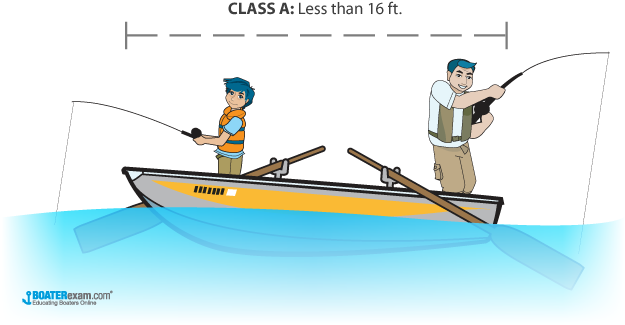
Boats measuring less than 16 feet.
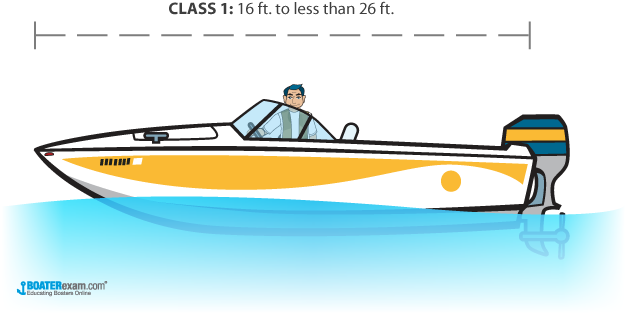
Boats measuring more than 16 feet but less than 26 feet.
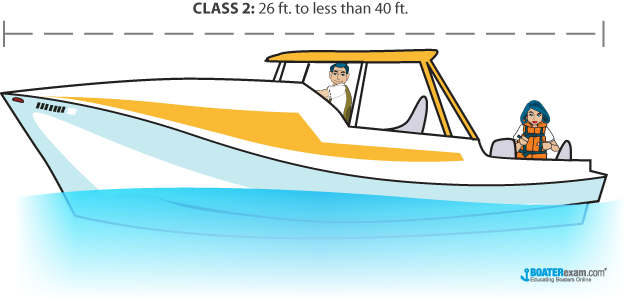
Boats measuring more than 26 feet but less than 40 feet.
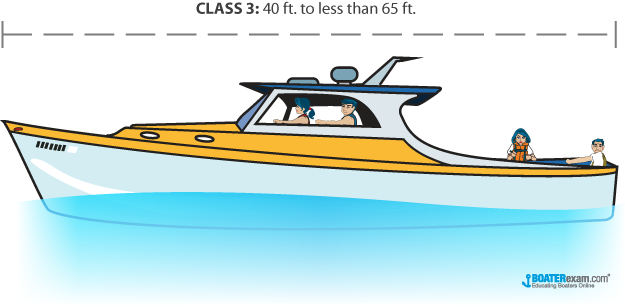
Boats measuring more than 40 feet but less than 65 feet.
How To Determine a Boat's Size
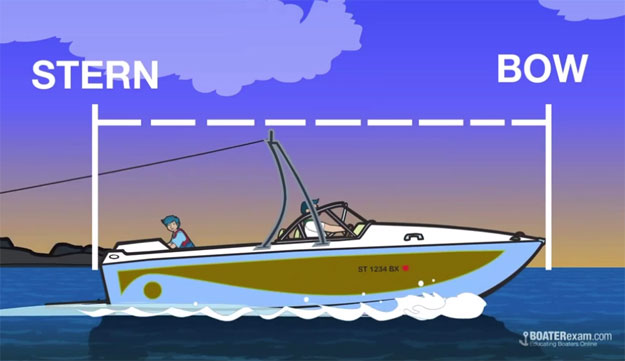
To find out a boat's length, measure along its center line from the outside of the bow to the outside of the stern. That means any attachments, such as swim platforms or wakeboard towers, don't count towards its length.
Boat Engine Types


U.S Navy Commissions USS New Jersey, First Ever Submarine For A Mixed Gender Crew

World’s Largest Hotel-Branded Superyacht Sets Sail For Maiden Voyage

India Establishes Its First Maritime Arbitration Center

Yanmar Unveils Its First Electric Propulsion Product For Emission-Free Sailing

The Ultimate Guide to Different Types of Boats – Top 20
As we all know, a boat is a type of watercraft that has been specifically designed for navigating near-shore areas or inland waterways such as rivers and lakes.
What makes a boat different from a ship is its smaller size and lesser carrying capacity compared to the latter.
However, the definition of a boat –its size, shape and capacity-varies according to its purpose. To understand better, you might want to read about the major differences between boat and ship .
According to modern naval terms, a boat is defined as a watercraft that is small enough to be carried abroad a ship (some boats are measured up to 1000 feet in length).
Similarly, many boats are intended to provide service, not in near-shore areas but in the offshore environment.
Interestingly, contradicting the “ships can carry boats, but boats can’t carry ships” argument, even sometimes the US Navy submarines are called boats.
Historical evidence suggests that the boat has been used for transportation since pre-historic times. However, from the oldest known boat named dugouts, the evolution of the watercraft has now reached luxurious motor yachts.
Apart from recreational purposes, boats have also served an integral purpose in the modern commercial world by allowing active transportation of both passengers and cargo, wherever short distances are concerned.
Table of Contents
Types of Boats
Technically, there are several different types of boats, and it’s impossible to list down all the types. But, primarily, boats can be classified into three main sections as follows:
- Unpowered or man-powered boats (like rafts, gondolas, kayaks, etc.),
- Sailboats (sail-propelled)
- Motorboats (engine-powered)
Here we have a list of the major types of boats in the above-mentioned categories of vessels, along with boat pictures used around the world.
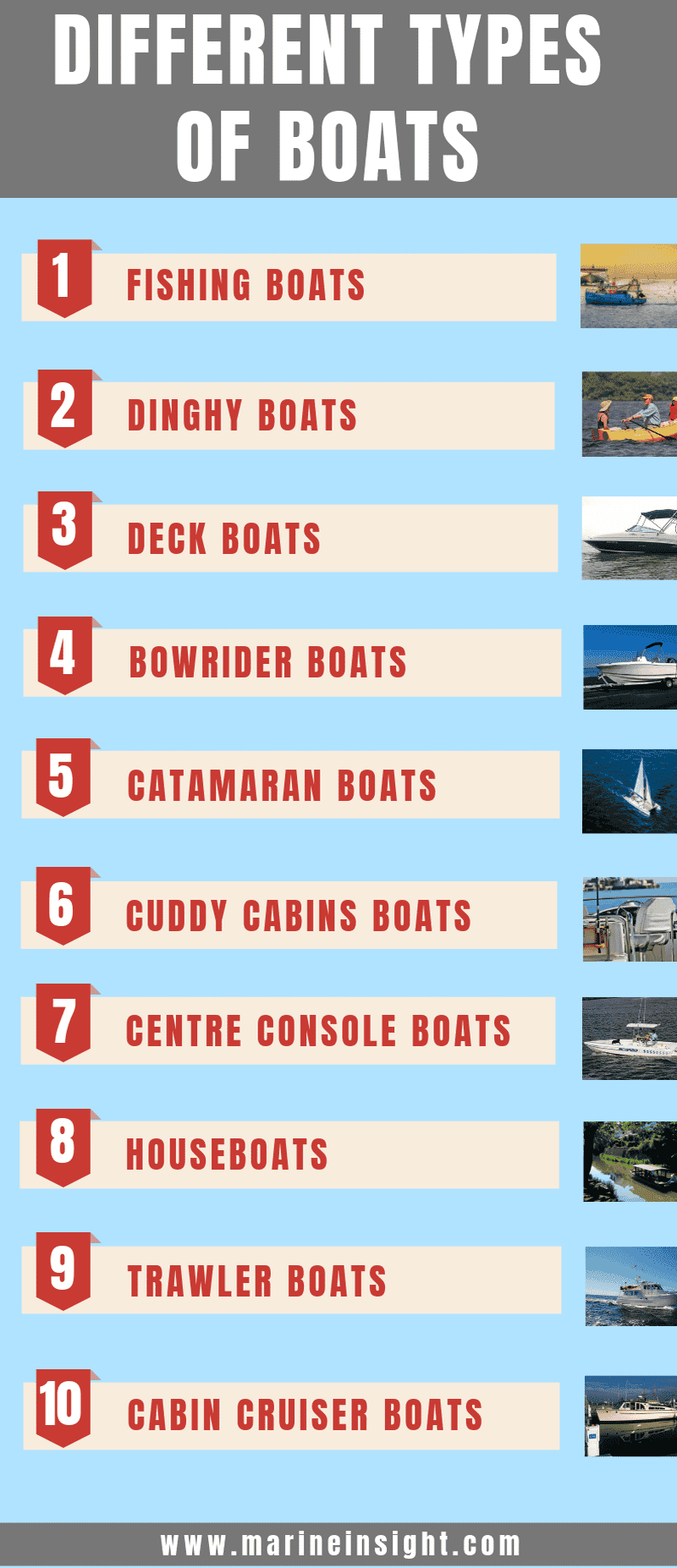
Related Read: 5 Biggest and Magnificent Sailing Ships of All Time
1. Fishing Boats
Built exclusively for fishing, fishing boats in different sizes are used on both salt and freshwater bodies. The immediate qualities of these boats include stability, strength, and durability to survive the fishing ventures across various kinds of waterways.
Fishing boats can be both manned and un-manned types. The all-purpose fishing boats generally include a front bow, rod lockers, a trolling motor system, an outboard power and live wells.
Compared to the boats meant for lakes and rivers, the boats fishing in the offshore environment will be taller in size and strong-built to withstand saltwater and harsher conditions.
On the other hand, the aluminium fishing boats weigh less and are highly durable. The bass boats designed with slim profiles, and consist of 2-3 anglers on board, are type of a boat used for fishing.

Related Read: Types of Fishing Vessels
2. Dinghy Boats
A dinghy can be a small inflatable boat usually made of rubber and comprises cross thwarts and rowlocks that act as seats and oars, respectively.
Commonly powered by sails, oars and small outboard engines, Dinghies are popularly known as sailboats, rowboats or simply inflatables.
These boats team up with more significant vessels and come in handy when the mothership cannot navigate in narrow areas. These rowboats can also be utilised as companion boats and are taken to camping expeditions or fishing in shallow waters.
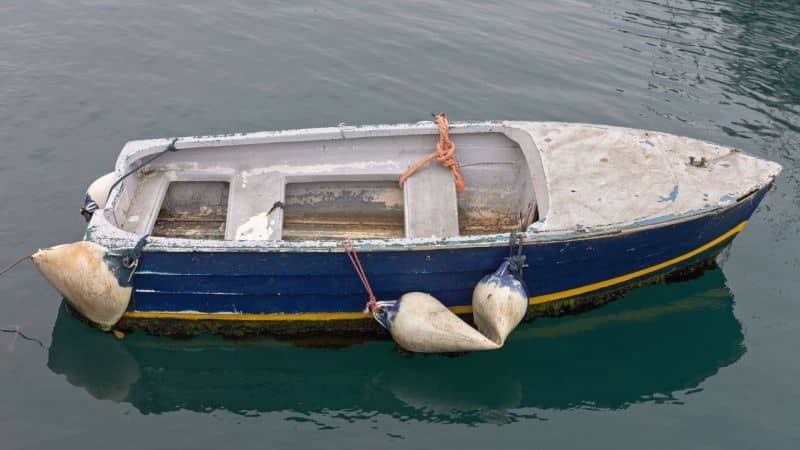
Related Read: Differences Between a Ship and a Boat
3. Deck Boats
As the name suggests, Deck Boats come with an open deck area that provides plenty of seating arrangements for a small group of people.
The boat features a V-shaped hull with a wide beam to accommodate more passengers than a pontoon boat. Usually measures 25-35 ft in length, they are provided with a stern power drive and are popularly used for recreational activities like swimming, water sports etc.
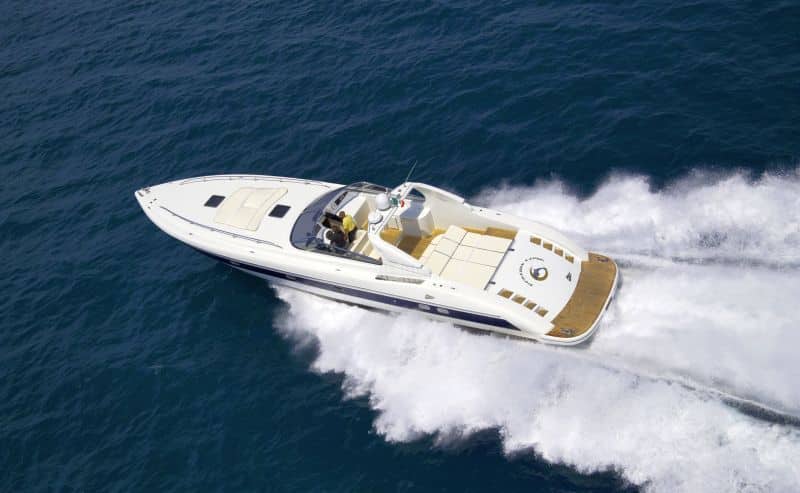
4. Bowrider Boats
Known as a quintessential family boat, Bowriders offer room for eight or more passengers across its cockpit, bow cockpit and helm. In addition, the bow area of these boats has been constructed in a unique way to allow a spacious seating arrangement.
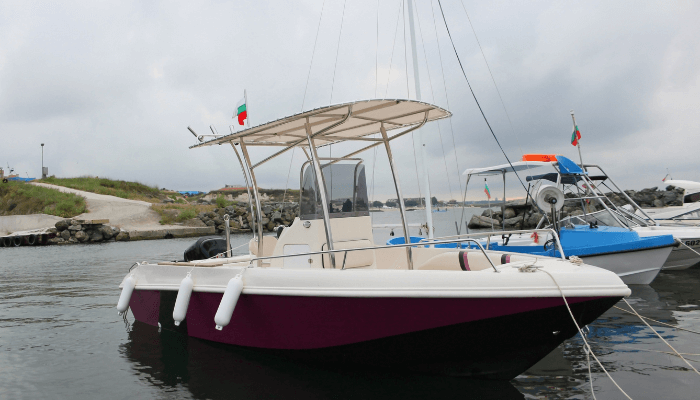
Moreover, these runabout-style vessels contain a swim platform for putting on wakeboards or for swimming activities feel-good leisure boating.
With its classic V-shaped bottom, Bowrider Boats offer a splendid ride across different water conditions. The usage of sterndrive power is the typical rule, but the demand for outboard engines is increasing rapidly.
4. Catamaran Boats
Unlike other boats, Catamaran is a multi-hulled watercraft that features two parallel hulls of equal size. Catamaran Boats feature less hull volume, shallower draft, and higher displacement than vessels with a single hull.
Excellent for fishing purposes and even for leisurely cruising abilities, Catamarans are being built for various purposes across the world.
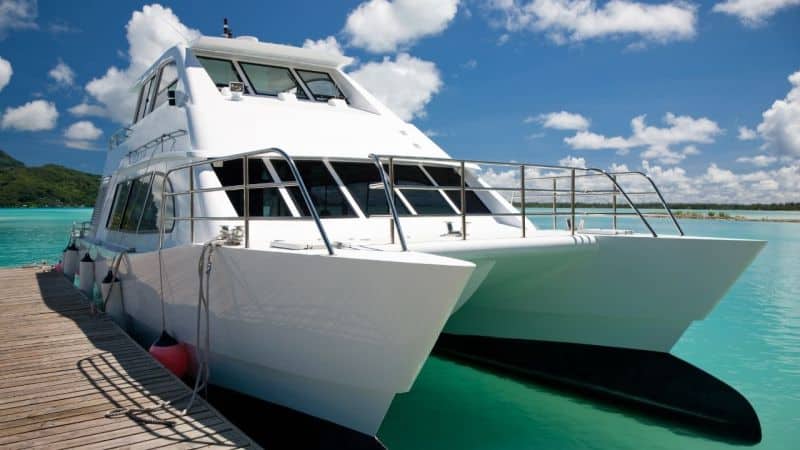
Related Read: Main Types of Catamarans Used in the Shipping World
6. Cuddy Cabins Boats
Well-suited for fishing, yachting, sailing and other water sports, Cuddy Cabins Boats is one of the most family-friendly vessels.
Featuring a closed deck over the boat’s bow, the boat allows a convenient storage space and easy navigation. The cuddy cabin boats are usually built of fibreglass and aluminium, and the minimum length is around 4.75 meters.
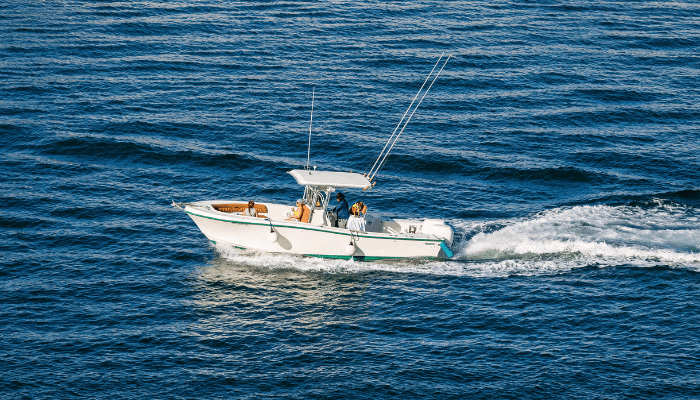
7. Centre Console Boats
Essentially a boat that features a hull with no cabin or foredeck and the helm station in the centre of the boat, Centre Consoles are great fishing platforms.
These boats are ideal for sports fishing and work in harsh offshore waterways with plenty of ocean fish. The essential equipment consists of bait wells, gunwale rod holders, fish lockers and outriggers, to name a few.
In addition, the deck provides a powerful insulation system for icing the fish storage.
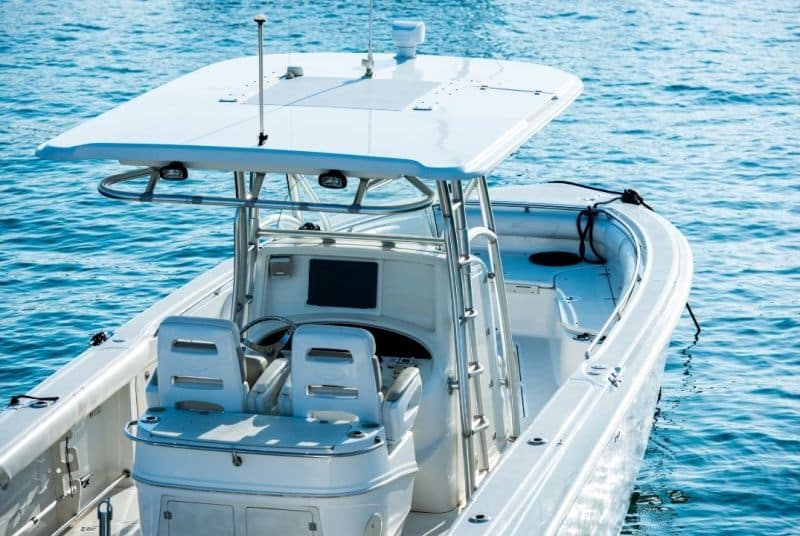
Related Read: Lafayette – The World’s Biggest Ship for Fish Processing
8. Houseboats
There are houseboats of different shapes and sizes worldwide, offering the luxury of living on water and providing excellent recreational and holiday accommodation facilities.
Houseboats, also known as Float house, incorporate broad flooring and modern amenities such as entertainment, fine dining, and proper sleeping arrangements.
The boats offer fun activities like relaxed cruising, water sports, family sailing etc. While most of the houseboats are motorized, there are boats incapable of operating under their own power since they are usually kept stationary at a location.
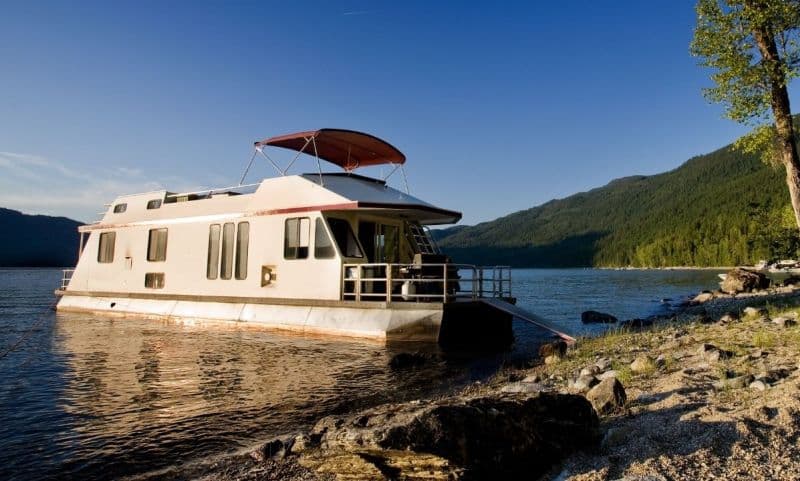
Related Read: Top 10 Largest Cruise Ships in 2017
9. Trawler Boats
With features including a displacement hull and fuel-efficient engines, trawlers are intended to smoothly manoeuvre through the water bodies without exhausting much horsepower or consuming excessive fuel.
This quality makes the trawler a brilliant option for long-range cruising activities, as all modern facilities can be found aboard the boat.
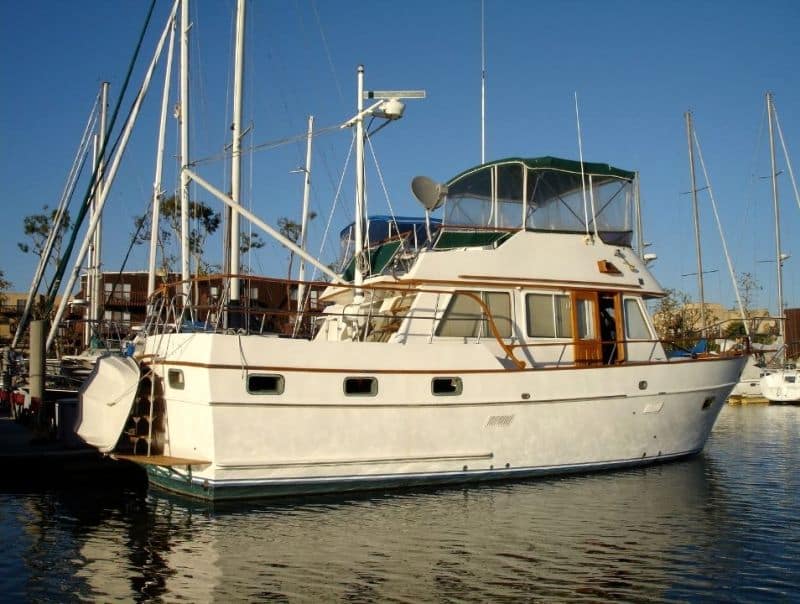
10. Cabin Cruiser Boats
Offering all the essential features of a home, Cabin Cruiser boats are great for relaxed sailing. Designed with a galley and a berth, these boats offer modern comforts like heaters, air conditioners, and power generators.
In addition to a deep-V bottom, the Cabin Cruisers employ a secure shaft drive mechanism plus rudder steering and therefore are mainly suited for movement in the salty water.
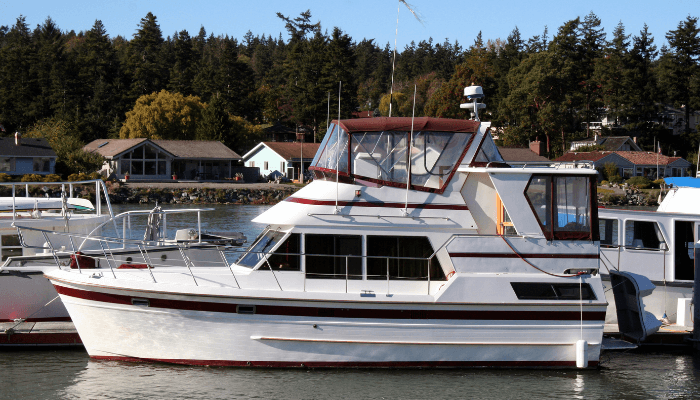
11. Game boats
Powered by diesel or petrol engines, these fibreglass boats are large in measurement and are useful for the game fish pursuit, especially pelagic fishes like tuna and marlin.
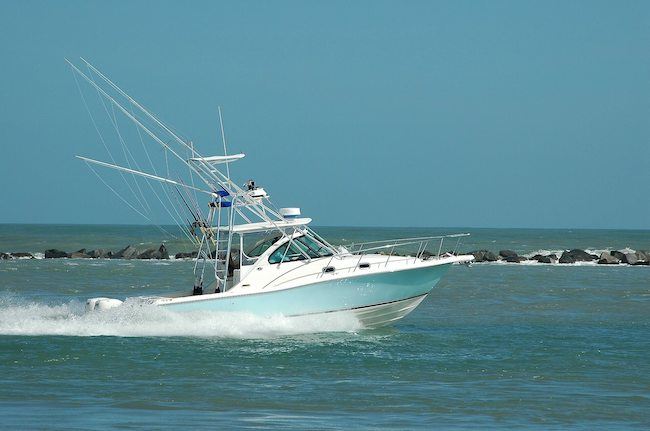
Equipped with sleeping berths, plumbing systems, and cooking galleys, these boats allow passengers to continue their activities for a couple of days or more.
12. Motor Yacht Boats
The latest design in the evolution of boats, the motor yacht, is a watercraft primarily used for leisure activities. The motor yacht has a standard length of 12m and above, with one or two diesel engines per navigation requirements in inland waters or the oceans.
The motor yacht can vouchsafe for an enjoyable family trip for a long period of time that it sails on the water. There are different types of yachts in the market, including day sailing yachts, weekender yachts, cruising yachts, luxury sailing yachts etc. to meet the various requirements.
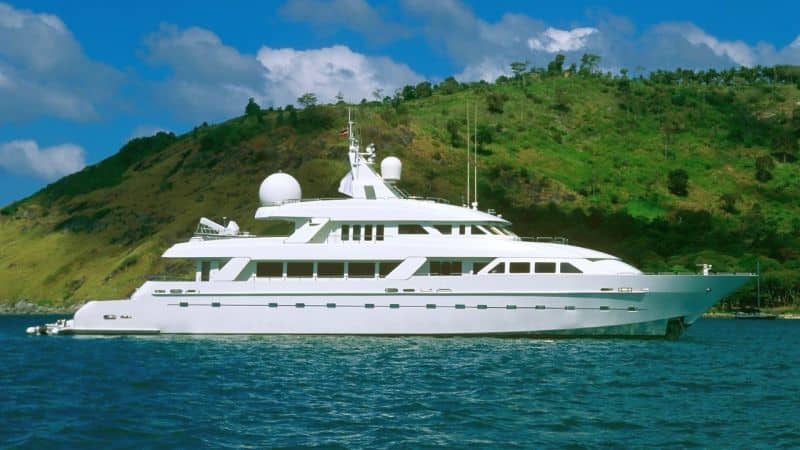
13. Personal Watercraft (PWC) Boats
The PWC boats, also known as water scooters and jetski, are customized boats for adventurous activities. This recreational watercraft allows individuals to explore the waters at their own ease and participate in games such as water-skiing and sports fishing, etc. There are two types of PWCs – “sit down” and “stand-up” models; while the former is intended for two or more people, the latter can only be used by a single rider.
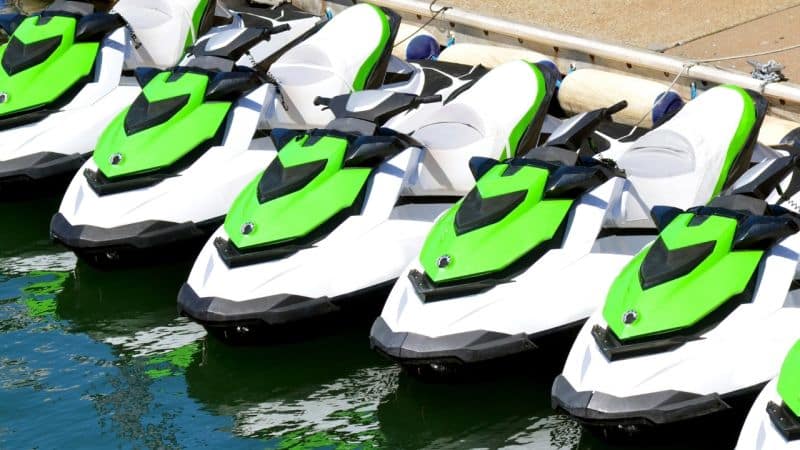
14. Runabout Boats
Capable of accommodating four and eight people, Runabout Boats are typically used in racing, fishing, water skiing, etc. The movement of these open boats is controlled by a steering wheel and forward controls, as located behind a windscreen. Runabouts are usually declared entry-level vessels for casual sports and boating activities.
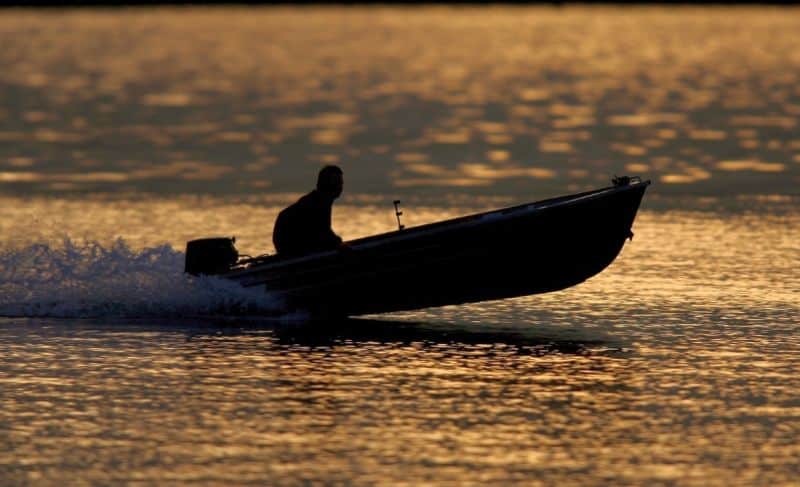
15. Jet Boats
Powered by a jet of water ejected from behind the vessel, Jet Boat is notable for its high manoeuvrability. The structure of a jet boat is quite similar to that of a bow-rider, as it offers a lot of seating areas and a swimming platform. In addition, the advanced propulsion system is securely enwrapped in the hull to protect it from any external damage.
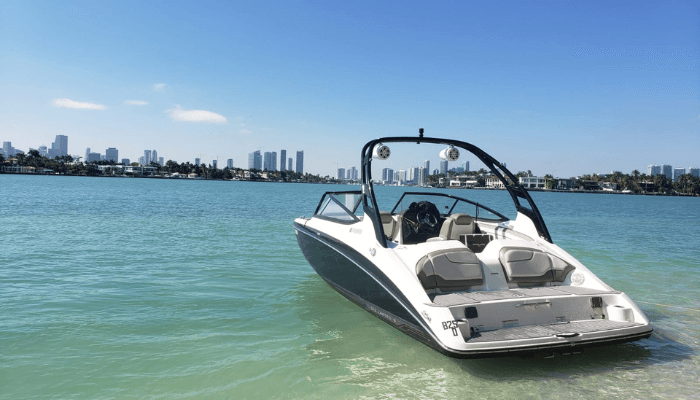
16. Wakeboard/ Ski Boats
The wakeboard boats and the ski boats look quite the same but differ in their fields of action. The inboard ski boats require a powerful range of acceleration, and the shape of the engine and propeller accentuates it. On the other hand, the inboard wakeboards feature a V drive engine system, deep hulls, and a huge wake to set in motion.

17. Banana Boats
A banana boat is a type of watercraft that is solely utilized for recreational activities and family entertainment. As the name suggests, it is a banana-shaped inflatable watercraft and easily floats on water. It does not have an inbuilt motor system. A banana boat has the capacity to seat around three to ten people. Interestingly, at the same, the vessels being used primarily for the transportation of bananas as cargo is also called Banana boats.
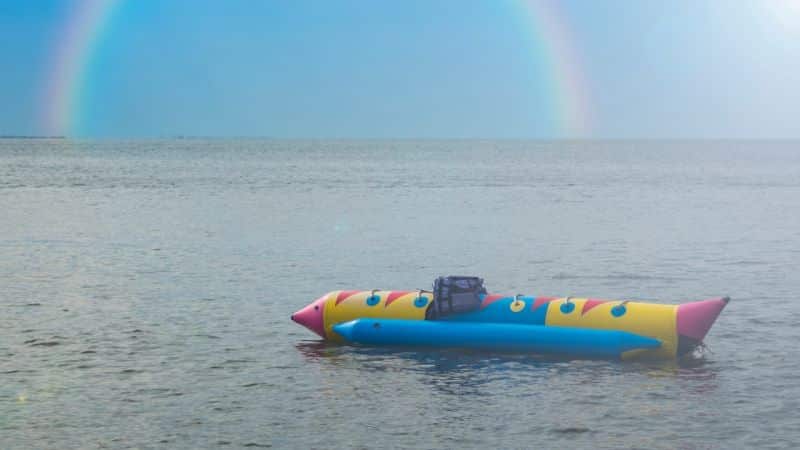
Related Read: Top 10 Most Expensive Private Yachts In The World
18. Lifeboats
In emergencies, lifeboats come to the rescue! The lifeboats are small watercraft attached to bigger vessels like cruises, and their main function is to carry passengers to a secure area if the concerned vessel is met with an accident. The lifeboats are well-equipped with immediate food and water supplies and other necessities to pacify the frightened voyagers in case of a shipwreck.
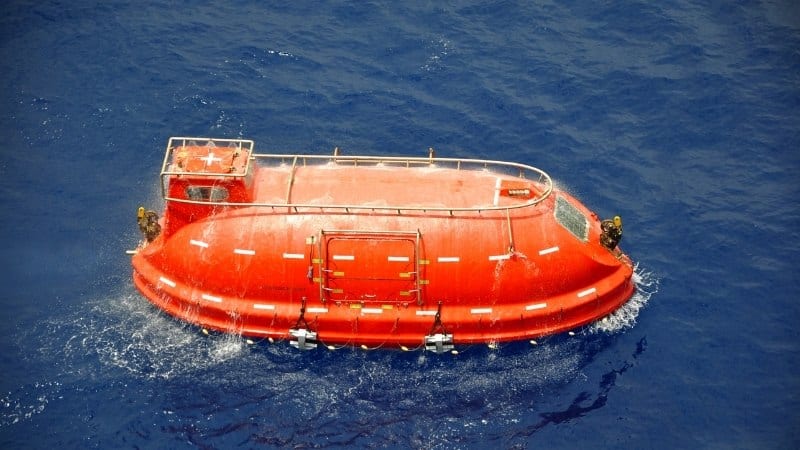
Related Read: Common Reasons for Ship’s Lifeboat Engine Starting Failure
19. Pontoon Boat
Used popularly for inland waters and other small water bodies, Pontoon boats are flattish in shape, relying on tubes (pontoons) to float on the water. Typically, the length of the Pontoon boat ranges from 15-30 ft with a shallow draft. It consists of multiple aluminium tubes supporting the broad platform providing excellent stability.
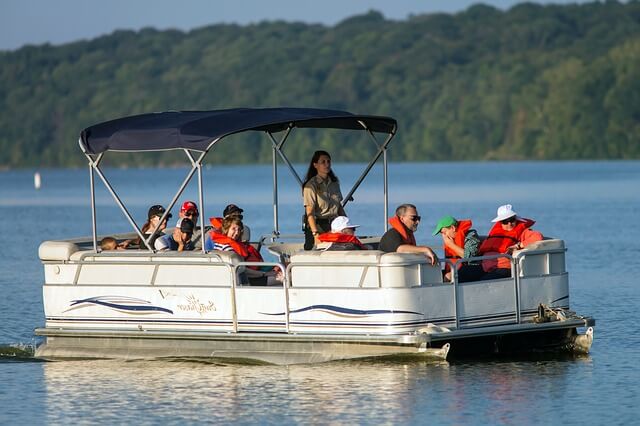
They are used for recreational activities like cruising and fishing etc. The shape of a Pontoon boat helps designers plan the seating arrangements and other facilities according to the requirements.
20. Sedan Bridge Boat
Typically ranging from about 35–65 feet in length, Sedan Bridge Boat by Sea Ray Company offers the pleasure of excellent visibility to the navigator. With an extended bridge area, the boat makes the passengers feel like a big ship bridge and offers accommodations down below to suit extended stays on the water.

Apart from the above-mentioned ones, several other types of boats are also available in the market.
The list of the boats continues with vessels such as Skiff or Jon Boats, Hydrofoil boats, Cigarette boats, Cuddy Boats, Tug Boats , High-Speed Crafts, Bumper Boats, Pilot Boat, Fire Boat, Well boats, Kayak, Bay or Flat Boats, All-Purpose fishing Boats, Deck Boats, High-Performance Boats, Rafts, Surfboats, Narrowboats, Folding Boats, Log Boats, Go-fast Boats, Catboats, Junk Boats, Ferry Boats, Canoe Boats, U-boats, Dory boats etc.
Over to you…
If you think any other type of boat should be added to this list, let’s know in the comments below.
You might also like to read:
- A Guide To Types of Ships
- Types of Sailboats: A Comprehensive Classification
- Different Types of Submarines and Underwater Vessels
- Different Types of Barges Used in the Shipping World
- LNG Tankers: Different Types And Dangers Involved
- What is Karadeniz Powership?
- Top 11 Books On Boating
Disclaimer : The information contained in this website is for general information purposes only. While we endeavour to keep the information up to date and correct, we make no representations or warranties of any kind, express or implied, about the completeness, accuracy, reliability, suitability or availability with respect to the website or the information, products, services, or related graphics contained on the website for any purpose. Any reliance you place on such information is therefore strictly at your own risk.
In no event will we be liable for any loss or damage including without limitation, indirect or consequential loss or damage, or any loss or damage whatsoever arising from loss of data or profits arising out of, or in connection with, the use of this website.

Do you have info to share with us ? Suggest a correction
Daily Maritime News, Straight To Your Inbox
Sign Up To Get Daily Newsletters
Join over 60k+ people who read our daily newsletters
By subscribing, you agree to our Privacy Policy and may receive occasional deal communications; you can unsubscribe anytime.

BE THE FIRST TO COMMENT
13 comments.
Though the personal watercraft boat seems like it would be an adventure, I’d prefer the classic fishing boat with an outboard power and live wells. I love fishing and this probably suits my needs just fine. It could also be that I don’t know how to swim either and this just seems safest.
Add another catergory Power Sailer. My Imexus 28 Trailer Sailer has a 180hp inboard whilst being generally sailing oriented. This catergory has some early examples like the Lancer 27, a big volume seller in the Macgregor 26Xand M and others like the Hunter X and Mackmam 28 All having large outboards fitted. Jimmy Buffett had one built I believe which was much bigger yacht again featuring a pair of 70 hp inboards I think. Just another catergory to add to the list. Regards Graeme
Well explained, I got some information about the bout on your article. I have shared it with my friend, who is planning to buy a boat. I am sure this post helps him to choose the right type of boat for him. He joined a yacht show in Thailand and like a boat from Boat Lagoon Yachting. Thanks for sharing.
@Johan: Glad the information came handy
I find it helpful that you made a list of boats with a detailed description of each. When I learned that a person can get a fishing boat so that they can be used to get saltwater and freshwater fish, my suggestion for boat buyers is to invest in a custom dock by a local contractor before buying one. Doing this will help them have a safe place to keep it safe while not in use.
Got any recommendations for a single man boat? I’m writing a character who likes the freedom of getting on his (modest) motor boat and taking off for the afternoon/evening. Below deck accommodations w/b great too. But I wouldn’t want to cost to be more than $20k. Any help is appreciated! Oh, and, he likes to go fast!
Nice post very informing. btw how do I know the difference between boats that are different that look the same?
I lovw boats so much! these are so cool! have you ever gone on a pizza boat they are the best things ever! carrbean pizza boats!!!!!!!!!!!!!!!!!!!!!!!!!!!!!!!!!!!!!!!!!!!!!!!!!!!!!!!!!!!!!!!!!!!!!!!!!!!!!!!!!!!!!!!!!!!!!!!!!!!!!!! i want to marry one one day. Lol.
This is really informative and i loved it i work with a marine company as a social media strategist and i was scouring the web for contents and i stumbled on this i thought i knew boats but now i know better thanks for the information btw i was wondering if you could give me permission to use some of these pictures for the content i’m creating. i’d love to hear from you soon. Regards
good information about boats
Banana Boats!! Seriously!!!
Leave a Reply
Your email address will not be published. Required fields are marked *
Subscribe to Marine Insight Daily Newsletter
" * " indicates required fields
Marine Engineering
Marine Engine Air Compressor Marine Boiler Oily Water Separator Marine Electrical Ship Generator Ship Stabilizer
Nautical Science
Mooring Bridge Watchkeeping Ship Manoeuvring Nautical Charts Anchoring Nautical Equipment Shipboard Guidelines
Explore
Free Maritime eBooks Premium Maritime eBooks Marine Safety Financial Planning Marine Careers Maritime Law Ship Dry Dock
Shipping News Maritime Reports Videos Maritime Piracy Offshore Safety Of Life At Sea (SOLAS) MARPOL
WAIT! Did You Download 13 FREE Maritime eBooks?
Sign-up and download instantly!
We respect your privacy and take protecting it very seriously. No spam!
Understanding Yacht Classifications and What They Mean
Types of yacht classifications.
Yacht Classification Types: A Complete Guide
If you’re new to the yacht world, understanding different yacht classifications can be overwhelming. Here’s a breakdown of the basics to get you started:
| Type of Yacht | Classification Features |
|---|---|
| Sailing Yachts | Wind-powered with or without auxiliary engine. |
| Motor Yachts | Entirely powered by engines. |
| Expedition Yachts | Designed for long-range travel in remote areas. |
| Sport Fishing Yachts | Built with fishing equipment. |
| Luxury Yachts | First-class amenities and lavish comfort. |
In addition to the traditional classifications, there are also subcategories within each that offer their own unique features and experiences.
Did you know that the concept of yachts has been around for centuries? The term “yacht” originates from the Dutch word “jacht,” which means “hunt” or “chase.” Yachts were initially used as small, fast vessels to chase pirates and smugglers. Nowadays, they serve as luxury vessels for relaxation and entertainment purposes.
If you want to feel fancy while getting wind in your hair, a sail yacht is the way to go – just don’t forget to bring your sea legs.
Sail Yachts
Sail Yachts have been around for 10,000 years! People are captivated by their ancient and dignified way of navigating the waters. They come in various shapes and sizes, from classic cruisers to advanced racing models. Each type has its own characteristics, depending on their use.
Let’s take a look at three types: Cutter Rigged , Ketch Rigged and Sloop Rigged .
- Cutter Rigged has two sails – mainsail and headsail. The headsail is higher than the forestay. Length Range: 28-60 ft.
- Ketch Rigged has two masts – mainmast and mizzen mast. Length Range: 30-80 ft.
- Sloop Rigged has one mast with a single head sail and mainsail. Length Range: 29-100 ft.
Motor yachts: When you want to feel like a millionaire without having to sell your organs!
Motor Yachts
Motor yachts offer the perfect combo of luxury and speed. These vessels provide occupants with all the latest amenities and let them cruise waterways in complete comfort.
To give an idea of the different motor yacht types, here’s a table:
| Classification | Length | Speed | Crew | Guests |
|---|---|---|---|---|
| Day Cruiser | 40-60ft | 30 knots | Bareboat | 6-12 |
| Sportfishers | 38-200ft | 25 knots | Crewed/ Bareboat | Up to 8 |
| Expedition | 70-400ft | 19-20 knots | Crewed | Up to 16 |
| Classic | 70-200ft | 10-15 knots | Crewed | Up to 13 |
Explorer yachts and open boats are other options. Take time to research before deciding what’s right.
Things to consider when buying or renting a motor yacht:
- Local regulations and licensing.
- Ask questions to brokers/owners.
Motor yachts are for those who demand high-speed, luxurious travel. When investing, remember to do your homework and ask essential questions. For an adventure, go for an expedition yacht – with all the luxuries and a crew to look after your needs.
Expedition Yachts
Expedition yachts are vessels with a special design, providing luxury and exploration capabilities. They are multi-purpose, able to travel long distances while carrying recreational vehicles like helicopters, submersibles, and speed boats.
The below table shows the popular types of Expedition Yachts available:
| Yacht Type | Length | Fuel Capacity | Guests | Crew |
|---|---|---|---|---|
| Support | 75m+ | 450000+ L | N/A | N/A |
| Explorer | 35-90m | 90000-300000L | 8-20 | 15-30 |
| Cruiser | 18-36m | 3800-15600L | 4-10 | 2-6 |
Expedition yachts feature decking for outdoor activities and interiors with wood or stone finishings. Guests can stay for weeks to months while exploring distant locations in comfort. The support type expedition yacht is designed purely for logistic uses, such as carrying supplies, fuel, and water equipment that may not fit on the explorer or cruiser vessels.
Pro Tip: When selecting an expedition yacht, make sure the destination is suitable for its capabilities. Also, check if your desired activities can be catered for within the available payload and size of your chosen yacht.
Classic Yachts: where vintage charm meets modern wallets.
Classic Yachts
When it comes to yachts, classic yachts are special. They have timeless designs and elegant features . Craftsmanship and attention to detail were important when they were built.
Classics can be divided into three categories. Sloops are the most common, 30-42ft long, with one mast and fore-and-aft sails. Ketches are 40-80ft, with two masts and main and mizzen sails. Cutters also have a single mast, but more sails – so they can adjust to changing wind conditions .
Nowadays, classic yachts are popular for their character and ability to handle tough waters. Racing regattas often have classic yacht classes, so sailors can compete and admire them.
The 1939-built Eilean is one of the most iconic classic yachts. It was even used by Italian navy cadets during World War II.
“If money won’t bring you joy, why do luxury yachts come with champagne fountains?”
Luxury Yachts
Luxury yachts are the epitome of extravagance in boats. These grand vessels boast lavish amenities and features that set them apart. Check out the following table to find out the different types of luxury yachts and their specifications.
| Type | Length | Speed | Cabins |
|---|---|---|---|
| Motor Yacht | 50-100m+ | 10-30 knots | 6-20+ cabins |
| Sailing Yacht | 25-90m+ | 10-20 knots (sailing) | 4-8+ cabins |
| Explorer Yacht | 35-100m+ | 8-20 knots | 6-16+ cabins |
People who want to admire the scenery and be treated with top-notch services usually opt for luxury yachts. Furthermore, these vessels are often staffed by highly-skilled maritime personnel whose main goal is to make sure their passengers have an unforgettable experience.
One of the earliest records of a real luxury yacht is from the renowned circular harbour of Syracuse, where the renowned inventor and scientist Archimedes designed a boat exclusively for pleasure cruising – which was unheard of in his era. Comparing today and then, it’s easy to see how far these floating mansions have come.
Trying to classify yachts based on size is like attempting to pair up socks – you just try to make them fit and pray they don’t get misplaced.
Classification by Yacht Length
Classification of Yachts Based on their Length
Yachts are classified based on different parameters, and one of them is their length. The classification by yacht length generally divides yachts into five categories: small, medium, large, superyachts, and megayachts.
The following table highlights the key details of each yacht length category:
| Yacht Length | Small | Medium | Large | Superyacht | Megayacht |
|---|---|---|---|---|---|
| Length (ft) | 20-40 | 41-75 | 76-120 | 121-200 | >200 |
| Sleeping berths | 2-6 | 4-8 | 8-12 | 10-16 | >16 |
| Crew | 1-2 | 2-4 | 3-6 | 5-10 | >10 |
| Facilities | Basic | Basic | Luxurious | Opulent | Ultra-lux |
| Activities | Day trips | Coastal | International | Luxury | Ultra-lux |
Yachts in the small category usually have a length of 20-40 ft and can accommodate 2-6 people in their sleeping berths. They have basic facilities and are ideal for day trips. In contrast, superyachts and megayachts are luxurious and ultra-luxurious, respectively, with superior facilities and activities available for guests.
It is worth noting that yachts can also be classified based on their purpose, design, and usage.
According to yachtingreports.com, Feadship is known for building the most luxurious yachts in the world. When it comes to Mega Yachts, the only thing bigger than their size is the owner’s ego.
Mega Yachts
Mega Yachts – the ultimate seafaring experience!
Check out this list of some of the most impressive yachts:
- Eclipse (533 ft): built by Blohm + Voss
- Dilbar (511 ft): built by Lurssen
- Azzam (590 ft): built by Lurssen
- Topaz (482 ft): built by Lurssen
- Al Mirqab (436 ft): built by Peters Schiffbau
These yachts offer awesome amenities like swimming pools, helipads, movie theaters, and elevators . Plus, they’ve got state-of-the-art satellite TV, Wi-Fi internet, and sophisticated navigation systems.
If you plan to charter one, it’s best to bring a professional crew. And make sure to schedule your trip during good weather conditions so you can really enjoy the journey!
Super Yachts
When talking about Super Yachts, length is the main factor. Check out the below to get an idea of the different lengths and the corresponding classes:
| Length (in Feet) | Classification |
|---|---|
| 80-100 | Small Super Yacht |
| 101-150 | Medium Super Yacht |
| 151-200 | Large Super Yacht |
| Over 200 | Mega/Super Mega Yacht |
These boats are built with advanced propulsion systems, hybrid power systems and eco-friendly tech to guarantee efficient fuel use and minimal environmental effects.
To make the journey even more luxurious, customizations can be done on request – like personal staff, chefs, masseurs, nannies, wellness instructors; routes to take you to your desired location; Michelin-starred catering; and entertainment options.
For those just wanting to have a taste of luxury, super yachts can be rented for special occasions and events like corporate meetings, private weddings, honeymoons and more.
In the end, owning or renting a super yacht will give you a unique and lasting experience that will reflect its high standards. A bigger dock is needed for these big baller yachts!
Large Yachts
Let’s explore large yachts! The table below explains the differences:
| Length (meters) | Guests | Crew |
|---|---|---|
| 24-30 | Up to 8 | 2-4 |
| 30-39 | Up to 12 | 5-7 |
| 40-49 | Up to 12 | 8-10 |
| Over 50 | Up to 20+ | Depends |
Apart from size, these boats have unique designs, luxurious amenities and exclusive services.
If you want a large yacht, be prepared for the extra responsibilities. Maintenance, safety and the right crew are essential.
Mid-sized yachts are the perfect choice for those who want to show off, without breaking the bank .
Mid-sized Yachts
Mid-sized yachts are a must-have for seafarers and cruising fans. These vessels range from 40 to 80 feet in length, giving plenty of room for a great voyage. Take a look at the stats for more details!
Small yachts may not be showy, but they’re ideal for honing your parking abilities.
For 40-50 feet , motorboats offer sleeping for 6 and range up to 300 miles. For 50-60 feet , motor or sailboats provide sleeping for 8 with sailboats having a range of 350 miles and motorboats up to 500 miles. 60-70 feet boats are either motor or sail, sleeping up to 10, and have a range of 500 miles (motor) or unlimited (sail). 70+ feet boats can sleep over 12, and their range depends on fuel and tank capacity – longer than 2K nautical miles and inclusive of all luxuries.
Choose mid-sized yachts for the ideal combination of comfort and convenience. Don’t miss out on the chance to enjoy unforgettable oceanic voyages – consider investing in a mid-sized yacht today!
Small Yachts
Yachts come in many sizes , with small yachts ranging from 20-30 feet long. They’re affordable and convenient for recreational water-goers! These vessels are perfect for day trips or short weekends.
When packing, focus on the basics – food, water, and safety items . Also, invest in durable, lightweight gear that can be stored on board. Additionally, practice good boat maintenance. Cleaning and oil changes can extend the life of a small yacht and make sure you’re safe at sea.
Find the right yacht for you, whether it be to impress your friends or flee your enemies .
Yacht Classification by Purpose
Yachting is a recreational activity that involves the use of yachts, which come in varying styles and sizes. Different yacht classifications by their purpose exist to help enthusiasts select the right type. A yacht classification by purpose is a system that categorizes yachts based on their intended use.
The table below outlines the common yacht classifications by purpose, their description and intended use:
| Classification | Description | Intended Use |
|---|---|---|
| Cruiser | A yacht designed for long trips with comfortable living quarters | Voyages |
| Sportfish | A yacht designed for fishing enthusiasts | Fishing |
| Motor Yacht | A yacht that focuses more on luxury and comfort, with an emphasis on power | Sightseeing |
| Catamaran | A yacht with two hulls that provides more space and stability | Chartering |
| Day Cruiser | A yacht designed for day trips, suitable for lakes and rivers | Day Trips |
Yachts are designed to meet specific tasks such as cruising, fishing, sightseeing, and day trips. Cruisers are the most commonly used yachts as they are designed for voyages and long trips . A Motor yacht is designed with an emphasis on luxury and comfort, making it ideal for sightseeing.
Recently, there has been an increase in demand for catamarans as these yachts offer more space and stability than traditional yachts. These yachts are increasing in popularity for charters.
A friend once shared how he got lost at sea on a long journey on his Cruiser. Thankfully, he didn’t get too lost and managed to find his way back on track. This highlights the importance of understanding yacht classifications and their purpose before embarking on any trip.
Racing yachts: where millionaires go to see who has the fastest toy boat.
Racing Yachts
Racing yachts are crafted to take part in sailing contests. They are built for speed, agility and responsiveness , making them perfect for experienced sailors. Let’s go further into the amazing world of racing yachts!
| Boat Name | Boat Type | Boat Length | Sail Area |
|---|---|---|---|
| Wild Oats XI | Maxi yacht | 100 ft (30m) | 11,915 sq.ft (1,108 m2) |
| American Magic | America’s Cup Class yacht | 75-90 ft (22.86 – 27.43 m) | 4,628-6,824 sq.ft (430 – 634 m2) |
| Pendragon IV | Farr/Marten | – | – |
When it comes to charter yachts, nothing beats owning one – except for knowing someone who does!
Charter Yachts
When renting a charter yacht, unique details must be taken into account. For example, the check-in procedure can take up to an hour – contracts must be signed and house rules must be reviewed. Additionally, in-season prices can increase by up to 30%, plus any applicable GST Tax levy.
Historically, the commercial yacht charter industry was limited to small sailboats before the 20th century. With the industrial revolution and improvements in marine transportation, this living lifestyle became available to more people, which led to an increase in boat sales and accessibility for wealthy individuals.
If your fishing yacht isn’t catching any fish, just tell everyone you’re practicing your catch-and-release techniques!
Fishing Yachts
Fishing Yachts come in sizes from 20-70 feet , and can host 1-3 crew members . Specialized fishing equipment is featured, such as chairs, live wells, bait stations, fish boxes, outriggers/rod holders, Sonar/Fish finder , and a GPS mapping system .
Capacity varies from 6-10 people for day trips, up to four guests overnight. Pro tip – before heading out, make sure you have all the necessary licenses and permits in place .
Sail into luxury with Fishing Yachts – where the boat and the lack of responsibilities are both equally luxurious.
Leisure Yachts
People looking to relax turn to leisure yachts as a means of escape. These boats are made with comfort and luxury in mind. So, let’s look at the types of leisure yachts.
Motor Yachts use power for speed and smooth sailing. Sailing Yachts use only wind to carry you, for a unique experience. Catamarans have multiple hulls for stability and plenty of room for activities. Trawler Yachts provide comfort for long trips.
Every yacht has its own special features. Some boast spas or movie theaters. Others have helipads for convenient shore access.
Did you know Jeff Bezos, Amazon CEO , owns the largest superyacht? Called ‘Flying Fox’, it’s 136 meters long and can accommodate 25 guests in 11 cabins. Plus, it has 54 crew members! And don’t forget expedition yachts – perfect for exploring the sea and bringing your shoes.
Expedition Yachts are perfect for those seeking adventure and luxury! They come in lengths of 80-400 ft., can accommodate 10-30 guests, and have a range of 3,000 – 10,000 nautical miles.
These yachts come with all the necessary equipment for exploration, including helicopters, submarines, dive centers, and have large storage spaces and extra fuel capacity.
One remarkable Expedition yacht was designed for studying climate change in the Arctic region, with a custom-built removable seawater laboratory. It was able to traverse the Northwest Passage thanks to its exceptional design and features.
For the seasoned adventurer, an Expedition Yacht offers an extraordinary level of adventure – far more than other yacht types. Who needs a six-pack when you can experience the thrill of a sleek hull design?
Classification by Hull Design
Classification Based on the Hull Design
Different types of yachts are classified based on their hull design. The hull is the outermost layer of the boat that provides buoyancy and stability in the water. The classification is crucial as it determines the type of yacht suitable for specific water activities.
| Type of Yacht | Description |
|---|---|
| The Monohull is the most common yacht type with a single hull. It is also known as a displacement yacht, suitable for long journeys on the sea. The Monohull offers stability, comfort, and excellent handling in rough conditions. | |
| This yacht type has a flattened hull surface that enables it to plane across the surface of the water, reaching high speeds. Planing hulls are suitable for leisure activities that involve speed such as waterskiing, tubing, and fishing. | |
| A Catamaran is a twin-hulled yacht that offers greater stability and space compared to monohulls. The absence of a keel allows the yacht to access shallow waters. Catamarans are suitable for large groups of people and long-term cruising. | |
| A Trimaran is a yacht with three hulls. The extra hull adds stability to the vessel, allowing the yacht to achieve high speeds while remaining stable. Trimarans are suitable for racing and long cruises as they offer excellent handling and speed. |
The length of the yacht also influences its classification. Usually, small boats are classified as dinghies, whereas larger boats are classified as yachts. The size of the yacht affects its stability, speed, and capacity.
It is essential to select the appropriate yacht type based on the activity and the number of people involved. For instance, if one is planning to host a large group of people, it is advisable to opt for a Catamaran or Trimaran rather than a Monohull. The Catamaran or Trimaran offers more space and stability in the water, ensuring the safety and comfort of the passengers.
Monohull yachts may not be as flashy as their multi-hull counterparts, but they still have one thing in common – they’ll break the bank faster than you can say ‘anchors aweigh’.
Mono-Hull Yachts
Multi-hull yachts are the way to go—they are usually faster and better equipped than mono-hulls for aggressive sailing.
There are various types of mono-hull yachts available in the market, each with unique features that cater to different types of sailors. For example:
- Cruiser/Racer: Offers comfort for cruising and great seaworthiness.
- Racing Boat: Lightweight and speedy, minimal comfort amenities.
- Cruising Sailboat: Mainly for recreational purposes, with spacious interiors, stability, and storage space.
- Daysailer: Small boats for short trips, day outings or beginners.
Plus, the simple design of the mono-hull yacht is highly customizable—so there are features that set them apart from others in the same category. For example, some racing sailboats have deep keels for stability in strong winds.
Finally, when purchasing a mono-hull yacht, consider factors like length/beam ratio, wetted surface area, and displacement. That way, you’ll be able to choose a vessel specifically made for your needs.
Multi-Hull Yachts
Multi-hull yachts are renowned for their unique structure as well as the comfort and space they provide. They are also known to be eco-friendlier due to their lower fuel consumption.
Catamarans have been popular for charter companies for their spaciousness and performance on long journeys. Trimarans , on the other hand, are favored for yacht racing thanks to their speed records.
Multi-hull yachts are a great option for those who want to sail with more freedom and flexibility. With two hulls, you get twice the fun! Even ancient Polynesians used outrigger canoes with multiple hulls to traverse the Pacific. And over the centuries, these vessels have continued to evolve and dominate the waters.
Catamaran Yachts
Catamaran Yachts have some unique features. Such as: spacious interiors, shallow draft and narrow beam. These give better speed & performance with less power. But, they are less maneuverable in tight spaces and may be susceptible to windage & less responsive to heavy weather conditions.
Catamarans have been around for centuries, and have grown in popularity and sophistication. They are now considered a staple in the yachting world due to their design features. Boaters all over the world love them.
The best thing about Catamaran Yachts ? They have three hulls… and a bar!
Trimaran Yachts
Trimarans are sailing vessels with three hulls that offer stable and swift performance. Here’s a table comparing some popular models:
| Model | Length | Beam | Draft | Displacement |
|---|---|---|---|---|
| Neel 45 Evolution | 13.5m | 8m | 0.9m/2.5m (folded/down) | 10,700kg |
| Aquila 36 Sport Power Catamaran | 10.97m | 4.21m | .69m | .64 metric tons |
| Dragonfly Trimarans DF35 Performance Cruiser MKII TS Light Weight Touring Variant | 10.68m | 8.03 | -/2.15 |
The Neel 45 Evolution has a unique design and plenty of space. It offers elegance, performance and safety.
Aquila is great for those with experienced sailing skills, thanks to its stability in rough waters.
Did you know Ben Cohrs built the largest aluminum trimaran in North America? It’s 48’ x 40’ and cost $1 million!
There’s a yacht style to suit every taste . So don’t forget your sea legs!
Yacht Classification by Style
Yacht Classification by Style pertains to the different categories or styles of yachts. It is crucial to understand these classifications to determine which type of yacht is most suitable for the intended purpose.
A Table has been created below to provide a clear and concise overview of each classification and its characteristics.
| Classification | Description | Characteristics |
|---|---|---|
| Motor Yacht | Propelled by engines | Fast, spacious and luxurious |
| Sailing Yacht | Propelled by wind | Elegant, slow-paced and eco-friendly |
| Catamaran | Two parallel hulls connected by a frame | Stability, spaciousness and shallow-water access |
| Trawler | A type of motor yacht designed for long-distance travel | Fuel-efficient, seaworthy and comfortable |
It is noteworthy to mention that each classification can be further categorized based on size, layouts, and specific features.
When choosing a yacht, it is essential to consider the purpose, budget, and preferences. Additionally, one must also inspect the yacht’s condition and safety features and hire a reliable and experienced crew.
To maximize the yachting experience, it is advisable to plan the itinerary ahead, select suitable destinations, and engage in water sports and activities. These practices can enhance the enjoyment and create lasting memories.
“Contemporary yachts are like Tinder dates, modern and sleek on the outside but you never know what kind of baggage they’re carrying until you’re already on board.”
Contemporary
Contemporary yacht style features sharp angles and sleek designs . Glass and reflective surfaces, as well as advanced tech like touchscreens and automation systems are commonplace. Inside, neutral colors with minimal art is the norm.
Sustainability is key in today’s yachts. Materials science allows for the use of recycled plastic, cutting waste and environmental damage.
Yacht design has evolved since the 1920s when industrialists requested custom-built yachts with modern amenities and materials like steel and aluminum. Sustainable materials, technologies and luxury are hallmarks of contemporary yacht design .
Traditional
The Mediterranean sun and rolling Atlantic waves can be experienced on these majestic vessels. They evoke a sense of nostalgia for simpler times, as the traditional yacht style never goes out of fashion. It’s rich in history and stunning in design, making it an icon in maritime culture.
The focus on craftsmanship is unique. Many are built by master craftsmen, using techniques passed down through generations. Every yacht offers intricate details such as custom masts and sails, as well as ornately carved woodwork.
The Bloodhound is a famous example. This classic racing schooner has an impressive history – dating back to 1936. Lord St Helier built it to take part in regattas around Europe while displaying wealth and opulence.
The Bloodhound has timeless beauty and durability – after almost 80 years, it remains desirable. Traditional-style yachts exude class and have supreme technical efficiency. For those wanting to outrun both their problems and the storm, there’s the Expedition classification – perfect for rough seas and an adventurous spirit.
For those wanting to explore with the luxuries of home, Expedition yachts are the way to go. Durable hulls constructed of high-tensile steel and designed to handle any sea and weather conditions. Plus, they have spacious cabins, gourmet kitchens and even a helicopter pad ! With impressive fuel capacity and long-range capabilities, they make extended travel easy. Loaded with state-of-the-art research equipment, they’re ideal for scientific exploration.
Expedition yachts don’t just offer a comfortable experience – they let you get close to nature. Their sturdy construction and off-road capabilities mean they can navigate through rugged terrain, taking you on land expeditions or to remote islands. Plus, plenty of room for recreational gear like kayaks and paddleboards – perfect for an adventurous getaway.
Yachting Magazine’s 2020 Guide to Expedition Yachts sums it up nicely: “Some of the most notable Expedition yachts ever built feature robust hulls constructed of high-tensile steel.” It’s clear that durability is key in expedition yacht design, due to encountering rough weather and unchartered waters.
Forget a sports car – when you can have a yacht that goes from 0 to 60 knots in seconds?!
Performance
Yacht classification is based on performance. Speed, handling, and stability are factors to consider. There’s a table showing the different yacht styles and their performance.
There are three main styles of yacht:
- High Performance: 50+ knots. Nimble and responsive. May sacrifice comfort for speed.
- Cruise: 25-30 knots. Comfortable and stable. May sacrifice speed for speed.
- Racing/Cruising: 35-45 knots. Balance of speed and comfort. Depends on design features.
Each style has unique levels of performance. High-performance yachts can be divided into racing and cruising models. It’s important to consider the intended use of the yacht.
When making a big investment, it’s best to consult with experienced pros. Understand the nuances of each style’s performance to make an informed decision. This will enhance the boating experience.
Oh, and Flybridge ? Sounds like a fancy superhero hideout!
The Flybridge is found above the main bridge of a yacht. What makes it special? Five key features:
- Provides excellent visibility for better navigation and sightseeing.
- May feature a helm station with advanced tech for precise control.
- Popular spot for sunbathing, socializing and enjoying views during cruising.
- May feature a bar, dining area, lounge seating or even a Jacuzzi.
- Sometimes enclosed with canvas or hardtop structures for all-weather use.
Some yachts have multiple Flybridges for greater views and entertainment. For example, some superyachts have two or three decks linked by staircases. Get a yacht with a flybridge to enjoy Jacuzzi views, cocktails under the stars and maximum privacy. Who doesn’t love that?
Classification by Country of Build
Classification by Nation of Origin
Yachts are classified based on the nation where they were constructed. This classification provides valuable insights into the yacht’s design, construction quality, and performance. Different countries have their unique yacht standards, and they follow different rules and regulations. Therefore, the country of build provides a means to classify yachts into their unique quality and design categories.
The table below shows the classification of yachts based on their nation of origin.
| Country | Classification |
|---|---|
| USA | ABS, Lloyds |
| Italy | RINA, MCA |
| UK | GL, MCA |
| Germany | BV, GL |
| France | BV, MCA |
Yacht classification helps in identifying the construction standards and safety features. ABS and Lloyd’s are commonly used classifications in the United States, while RINA and MCA are widely accepted in Italy. For UK-based yachts, GL and MCA are the standard classifications, and BV and GL are the most common classes used for German and French yachts, respectively.
It’s essential to choose your yacht’s classification carefully, depending on its purpose, location, and usage. For example, if you plan to sail in European waters, it’s better to choose a yacht that adheres to RINA or BV standards. On the other hand, if you plan to sail in the United States, choosing ABS or Lloyd’s classification may be suitable.
In addition to considering the country of origin, other factors that can affect a yacht’s classification include age, size, and usage. It’s important to research and select the appropriate classification for your yacht to ensure safety, compliance, and performance.
Why settle for a fancy car when you can be cruising on a yacht, American-style?
The ‘Classification by Country of Build’ divides ships into their origin and construction. ‘ American ‘ denotes those made in the United States. This shipbuilding industry has a long history, covering many types of watercraft. From naval vessels to commercial ships, American-built machines have aided the economy and security.
Notable ships include the USS Constitution . This is the oldest, still-functioning naval vessel in the world. The Cutty Sark tea clipper is another example. It was a 19th-century British merchant ship built in Massachusetts. The Liberty Ship is another famous one. During World War II, over 2700 of these cost-effective cargo vessels were constructed to help allied forces.
Pro Tip: Even though American-built ships are sought-after, it is essential to check they meet international safety standards before sailing. So, why worry about Brexit when you can debate which country makes the best cars in Europe?
The classification of European ships is quite thorough. It includes Germany, Poland, Italy, the Netherlands and more. European vessels are renowned for their quality and tech. The European shipbuilding industry is competitive and eco-friendly.
European-built ships are also environmentally-friendly and have cutting-edge facilities. They can construct megayachts and cruise ships with luxury features .
Pro Tip: When you select a European-built vessel, research the shipyard carefully for the best quality! Stop settling for a dull kangaroo and choose an Australian-built car instead!
Australia is famous for its lush landscapes and wild creatures. But, did you know it also has a booming shipbuilding industry? Ships made in Australia are known for their superior quality and precision .
From small fishing boats to huge cargo ships, these vessels are respected around the world for their craftsmanship and dependability . Nowadays, many people choose to build mid-sized bulk carriers and other commercial ships in Australia.
Moreover, Australian shipbuilding focuses on sustainability and environmental protection . Yards use eco-friendly materials and methods whenever possible, to reduce the impact on nature.
If you’re looking for a vessel, choosing an Australian-made boat guarantees a top-notch experience. It will serve you well and you’ll know your decision backs a responsible and progressive industry. Don’t miss out on the chance to sail with a marvellous Australian-built boat – get one today!
Asian countries construct a variety of unique and exceptional boats. These boats show traditional techniques with modern advancements, making intricate pieces of art.
One example is the Sampan boat . It’s widely used in China and Southeast Asia for fishing and transportation. It has a flat bottom and curved sides, meant to glide through shallow waters.
Another creation is the Junk boat . It’s a Chinese sailing vessel known for its hull design and seafaring ability. It was used for trading across oceans, allowing sailors to traverse great distances.
These boats have been around for centuries and are culturally significant. The Yamanose fishing boats from Japan are renowned for their artistic design, featuring exotic patterns that reflect the country’s culture.
These beautiful vessels show the world’s diverse regions’ skills and expertise. They are timeless yet transcendent, leaving an impact on our world forever.
Yacht classifications are important for safety and efficiency. Knowing them helps you pick the right one. Each one has different features. For instance, some are made for open waters, others for near-shore.
When selecting a yacht, three main things matter: design, size, and purpose . Poor design can cause seasickness and ruin your trip.
Did you know? The first recorded sailboats were in ancient Egypt over 5,000 years ago. They were for fishing, not recreational use. Engineering has since created stylish, luxurious, comfortable yachts.
- THE PRINCESS PASSPORT
- Email Newsletter
- Yacht Walkthroughs
- Destinations
- Electronics
- Boating Safety
- Ultimate Boating Giveaway

- Uncategorized
Yacht Classifications
- By Dudley Dawson
- Updated: July 17, 2009
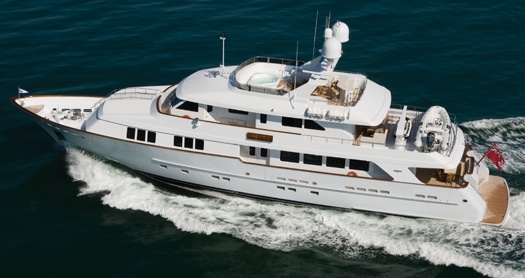
ytgjul17perf525.jpg
Let’s take a peek into the dark back corner of a London pub a couple hundred years ago, when Britain was the unquestioned ruler of the sea, as a group of Lloyd’s of London insurance underwriters licked their financial wounds from the latest loss of a cargo ship to Davy Jones’s locker. They’d had enough, and proposed to form an independent society to make ships safer by developing standards for construction, operation, and maintenance. Thus was born Lloyd’s Register of Shipping, no longer affiliated with Lloyd’s of London, but still the granddaddy of maritime classification societies.
The concept was so successful in improving safety and cutting losses that spinoffs and imitators soon appeared in other seagoing nations. There are now ten full members and one associate member of the International Association of Classification Societies ( www.iacs.org.uk ). Not all of them class yachts, and of those who do, not all class smaller yachts. The American Bureau of Shipping (ABS), for instance, does not class yachts under 24 meters, or about 79 feet, in overall length.
Each society also has different sets of rules and guides, several of which will be applicable to any given yacht. While national codes, such as the U.S. Coast Guard regulations, and international treaties, such as SOLAS, are mandatory, classification is in most cases voluntary. A shipowner or yachtowner elects to have his vessel classed in order to better assure a certain level of sound design and construction, and consequently, to reduce insurance premiums and losses.
Although there are differences in the details, the societies have much in common. Each issues written rulebooks and guides for use by designers, reviews and approves the vessel plans in advance of construction, and employs dedicated surveyors to assure that the vessel is built in accordance with the plans. There are also periodic inspections by this same corps of surveyors throughout the vessel’s service life to check that it is being maintained to the required standards.
The voluntary nature of classification creates a number of possibilities for a yacht owner. He can pick and choose from the several classification societies that cater to yachts. For instance, an American owner having a fast yacht built in Holland could choose to have it classed by the Norwegian society, DNV (Det Norske Veritas). This is where those detail differences come in, as some designers consider the DNV construction rules for high-speed vessels to be more realistic than those drafted by some other societies. Such shopping for classification is commonplace, and that’s why you’ll find surveyors for each society in each shipbuilding nation. In an Italian yard, for instance, you might find an ABS surveyor working on one vessel and a Lloyd’s inspector working on another, alongside the first. In some cases, where the surveyors are independent, or “non-exclusive” in society parlance, you might find him wearing a DNV jumpsuit one day and ABS coveralls the next.
In addition to choosing his classification society, an owner can choose the level of involvement he wants with classification. Full classification means plan approval before construction, inspection and approval of both construction and installed equipment (anchors, engines, generators, etc.), and periodic inspections and required maintenance after delivery. An owner can also add various options, including most recently, an environmentally based endorsement of the yacht as “green.”
All of this comes at a price, of course, both in meeting the initial requirements and in continuing costs. Some owners view any financial outlay as justified in protecting their vessel and those aboard; others elect to have the yacht designed and built to class, and then drop the class designation when fees and mandated maintenance expenses begin to exceed the savings in insurance premiums.
Finally, an owner can opt to have his designer and builder use the written classification standards as a guide in the construction of his new vessel, without actually contracting with the society. This avoids some of the expenses of questionable value, such as factory testing and equipment certification. Then an independent non-society surveyor or project manager can oversee the construction up to delivery, and the captain, vessel management firm, or favorite boatyard can track maintenance requirements. It’s not official, but it’s still classy.
- More Uncategorized

BoatUS Launches Online Advocacy Tool

Dock Danger

A Dream Fulfilled

3 America’s Cup Hashtags to Follow
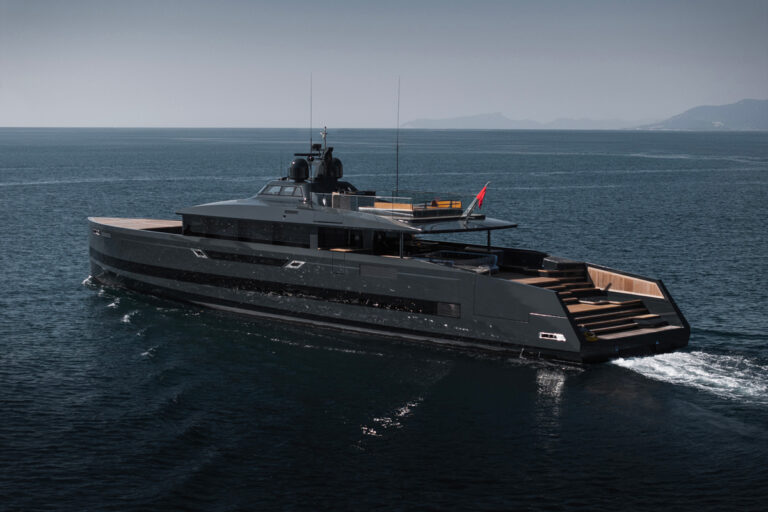
Alia Yachts to Debut SAN Superyacht in Monaco
Top Bar Harbor Maine Sights For Visiting Cruisers
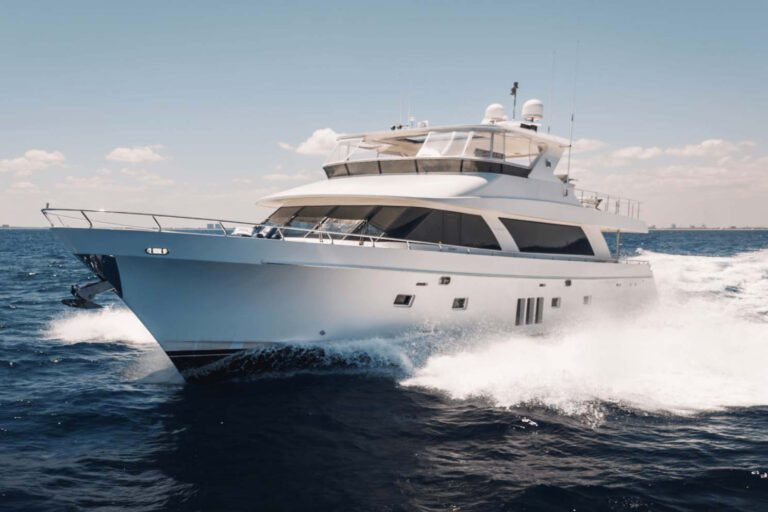
Always In Style: Ocean Alexander 85E For Sale
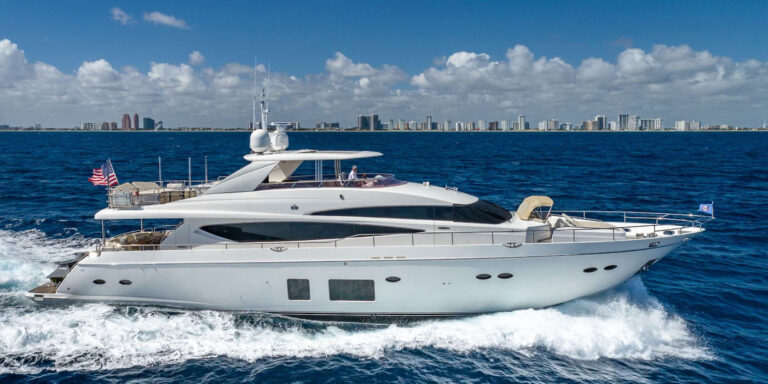
Spend Thanksgiving on a Yacht

- Digital Edition
- Customer Service
- Privacy Policy
- Terms of Use
- Email Newsletters
- Cruising World
- Sailing World
- Salt Water Sportsman
- Sport Fishing
- Wakeboarding
- San Lorenzo
- Yacht Rental in Dubai Marina
- Yacht Party Dubai
- Overnight Experience
- Formula 1 Abu Dhabi
- Corporate Events
- Fifa World Cup 2022
- Anniversary Celebrations
Connect with a yacht expert & get per personalised Deals

What Size is a Yacht
Yachts are boats used for leisure and are usually over 30 feet long. They come in different sizes; the more luxurious ones are between 30 and 60 feet, while the really big ones, called superyachts, are over 100 feet. Smaller boats for day trips are not yachts if they are less than 30 feet. Today’s article will discuss yacht sizes, dimensions, and classifications.

Yacht Sizes
| Small Yachts | Up to 40 feet |
| Medium Yachts | 40 to 70 feet |
| Large Yachts | 70 to 100 feet |
| Super Yachts | 100 to 200 feet |
| Mega Yachts | Over 200 feet |
To determine a yacht’s size, start by measuring from the front to the back end, which gives you the overall length. Remember, this measurement, known as length overall (LOA) , includes everything from the main deck to any forward-pointing parts or rear platforms.
The length of the part of the yacht that’s actually in the water is also measured, and it is called waterline length (LWL) . You must consider other dimensions, such as the width (beam) and how deep it sits in the water (draft). Yachts are weighed without any liquids on board to get the dry weight and with all liquids for the wet weight. If you add all the gear, you get the loaded weight. These are one of the characteristics or parameters that mark the difference between yacht and cruise .
Yacht Dimensions
| Sailing Yachts | 30-100 | 8-20 | 10-30 | 0.2-5.9 | 5-150 |
| Motor Yachts | 35-200 | 12-30 | 15-40 | 3-7 | 50-500 |
| Catamarans | 30-60 | 15-30 | 10-35 | 1-5 | 20-120 |
| Trawlers | 40-80 | 15-25 | 10-35 | 3.5 | 30-200 |
| Explorer Yachts | 60-400 | 20-50 | 15-60 | 3.6-5.0 | 200-10000 |
How Do Yacht Sizes Impact Their Handling

Yacht size significantly affects handling. Due to increased length and displacement, larger yachts have more momentum and take longer to respond to steering and power changes. They require more space to maneuver and have larger blind spots, especially under the bows. Smaller yachts are generally more agile and responsive.
Small yachts are easy to handle and quickly change direction, perfect for navigating tight spots. Larger vessels, such as explorer yachts built for long-distance travel, need careful steering and more time to slow down or stop. They often come with extra features like thrusters for precise control.
The yacht’s width, or beam, keeps it steady on the water; however, a wider yacht might not move as swiftly or turn as easily. The draft, which is how deep the yacht goes under the water, is deeper for better performance against the wind, but it means the yacht can’t go into shallow areas. The yacht’s height affects how much wind it can catch, which helps determine how far a yacht can travel and makes it more challenging to handle.
Yacht Classification
| Commercial Yachts | Business, charters | 50-180 ft |
| Private Yachts | Personal use | 40-200 ft |
| Charter Yachts | Rented for vacations | 50-150 ft |
| Luxury Yachts | High-end private use | 70-300 ft |
| Sport Fishing Yachts | Angling, tournaments | 30-100 ft |
When you are looking to charter a yacht, buy one, or rent it for a getaway, picking the right size is essential. It is all about matching the yacht to what you need, whether that’s room for a big group, special features for comfort, or just the right feel.
The size you choose has a big impact on how easy the yacht is to handle, where you can take it, and how many friends or family can come along. In addition, it has got to fit your budget. Getting the size right means you will have a better time on the water and save money.

Choosing the Right Yacht Size – Final Words
In the world of yachting, size does matter. It influences everything from the yacht’s handling and maintenance to the overall onboard experience. Whether you are a seasoned sailor or a leisurely cruiser, understanding the dimensions and classifications of yachts ensures that you select a vessel that meets your needs and delivers the comfort and performance you desire.

Qazi Raza Ul Haq
My name is Raza and I am an experienced SEO content writer who loves to explore and seek adventure. I have over 8 years of experience in blogging and SEO content writing. I would be delighted to take you on a thrilling journey to discover the world of yacht rentals in Dubai, providing you with valuable insights and helpful tips.
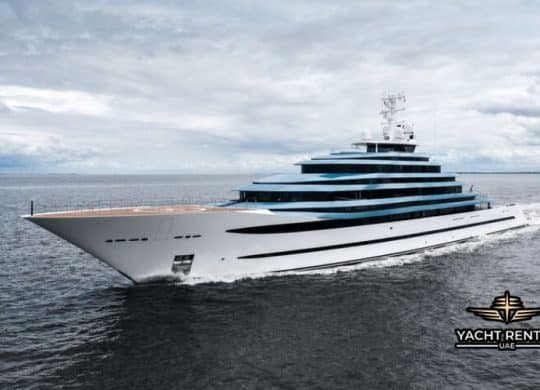
PER HOUR Per Day
Browse our Yachts

IMAGES
VIDEO
COMMENTS
Understanding What Size Boat Is Considered a Yacht: A Complete Guide" Determining what size boat is considered a yacht involves understanding various criteria and classifications. This comprehensive guide will delve into the definition and size criteria of yachts, explore the different types of yachts categorized by size, and discuss the regulations and standards that govern these vessels.
Yacht classification definitions. ... The number and type of the mandatory certificates depends on the size of the vessel; the following is an indicative list: International Tonnage Certificate: A measurement of the internal volumes of the yacht expressed in gross tons (GT). This measurement should not be confused with displacement tonnage ...
A yacht of 60 meters length will have a crew of 20-23 members. A yacht of 80 meters length can have a crew of up to 80 members. The maximum number of guests will depend on yacht registration type. Many owners choose to keep maximum of 12 guests, since it allows for a simpler regulation regime.
1. Luxury Yacht. Yachts are normally classified as any watercraft that can be used for pleasure or sport and can range from 30 ft to over 100 ft. While a yacht can be as small as 30 ft. long, a yacht is often considered a cabin cruiser until it is 39 ft. or more, then it is considered a proper yacht.
Yacht Sizes and Classifications. Coming in various sizes and classifications, each yacht offers its own features and amenities. The term "yacht" generally applies to vessels that have cabins intended for overnight use and that measure at least 10 meters, or 33 feet, in length.
Class 3: Boats measuring between 40 and 65 feet. This class includes yachts, sport fishers, catamarans, sail boats and go-fast boats. To operate this class of boat safely, you need to have: One approved Type I, II or III personal flotation device (PFD) for each person on board or being towed on water skis, etc. and one throwable Type IV device.
A. Small Yachts. Small yachts are typically less than 40 feet in length and are perfect for short trips and intimate gatherings. They are ideal for those who want a simple, low-maintenance vessel that is easy to handle. B. Mid-Size Yachts. Mid-size yachts are typically between 40 and 80 feet in length.
Discover the Perfect Yacht: An In-Depth Look at Different Types of Yachts. When diving into the world of yachting, understanding the "types of yachts" is essential. This comprehensive guide will provide an overview of the various yacht types, explain each type in detail, discuss yacht size and classification, offer tips on choosing the right yacht, and compare different types to help you ...
When narrowing your choices, there are two main yacht types on offer: motor and sail and each type has its unique properties to offer. Traditionally, motor yachts have more space and stability and are a popular choice for families or larger groups, while sailing yachts have the same high levels of luxury but are well suited to those who like ...
As per classification rules, a vessel dedicated for the aforesaid purposes is deemed to be a yacht only when it is over a certain length of at least 10 meters or 33 feet. ... Types of Yachts By Size. Based on length and size, yachts can be classified into the following categories: Megayachts: ...
Yacht Classifications. To fully grasp what defines a yacht, it's important to understand the various classifications within the yachting world. Yachts are categorized based on their size, propulsion methods, and intended use, helping to clarify what classifies a yacht. Sailing Yachts: These yachts rely primarily on wind power and sails. They ...
Yacht Sizes. You can find yachts in three size categories: yachts, superyachts, and mega yachts. While you can find some variation in how these terms are used, yachts are generally classified as being up to 100 feet long. Superyachts are between 100 feet and 200 feet long. Mega yacht is the term used for any yacht that is more than 200 feet long.
These determinations are based on the class of boat, which puts your craft into a size range. Class A less than 16 feet; Class 1 16 to less than 26 feet; Class 2 26 feet to less than 40 feet; Class 3 40 feet to less than 65 feet; SRV (small research vessel) Boats of 65 feet in length, yet less than 300 gross tons fit this category. ...
Yacht classification is a system used to categorize yachts based on various factors such as size, construction, and intended use. The specific classification categories and requirements can vary between different yacht classification societies, but some common classifications include: Pleasure Yacht: A yacht intended for leisure use, typically ...
Owners moving from smaller yachts into those over roughly 80 feet will quickly learn a new alphabet: ABS, DNV, BV, LR, RINA, and more. These are organizations that set rules governing the construction, maintenance, and operation of yachts. Called "classification societies," there are 13 members of the International Association of ...
Posted on 11 July 2023 by Guy Bolduc in Non classé. Understanding the Classification of Yachts A, B, C and D: Since 1998, Europe (EEC) classifies yachts according to 4 categories A or B or C or D and this is a law. In order to sell a boat in the large territory of the EEC, it must be classified with a plate that mentions its classification and ...
Offering you an unbiased and comprehensive yacht charter and yacht sales consultancy. www.salt-superyachts.com. [email protected]. +44 2038 821 364. Yacht classifications, also referred to as classification societies or class societies the that rules are an integral element of owning a yacht and an important part of maritime safety.
The class of boat you're operating will determine what precautions & equipment you're required to carry. Learn the different types & requirements for each. ... Boat Size Classifications & Requirements. Boat Classes By Length. Federal and state law requires that you have specific safety equipment on board depending on the class of your boat.
4. Bowrider Boats. Known as a quintessential family boat, Bowriders offer room for eight or more passengers across its cockpit, bow cockpit and helm. In addition, the bow area of these boats has been constructed in a unique way to allow a spacious seating arrangement. Image for representation purpose only.
Yachts are classified based on different parameters, and one of them is their length. The classification by yacht length generally divides yachts into five categories: small, medium, large, superyachts, and megayachts. The following table highlights the key details of each yacht length category: Yacht Length. Small.
The voluntary nature of classification creates a number of possibilities for a yacht owner. He can pick and choose from the several classification societies that cater to yachts. For instance, an American owner having a fast yacht built in Holland could choose to have it classed by the Norwegian society, DNV (Det Norske Veritas).
What Size is a Yacht. Yachts are boats used for leisure and are usually over 30 feet long. They come in different sizes; the more luxurious ones are between 30 and 60 feet, while the really big ones, called superyachts, are over 100 feet. ... Yacht Classification. Yacht Type: Typical Use: Length Range: Commercial Yachts: Business, charters: 50 ...
Yacht owners guide to Classification Societies. 21 January 2015 • Written by Benjamin Maltby. Alysia was built specifically for charter and complies to SOLAS. She can carry up to 36 passengers and is over 500GT. Classification societies (also known as 'class' societies) make an important contribution to maritime safety.